February 11th, 2025
16minute read
Hurricanes can be hell.
Typhoons are typically terrible.
But when it comes to all-around, rain-soaked, human misery, the tropical monsoon tops the charts.
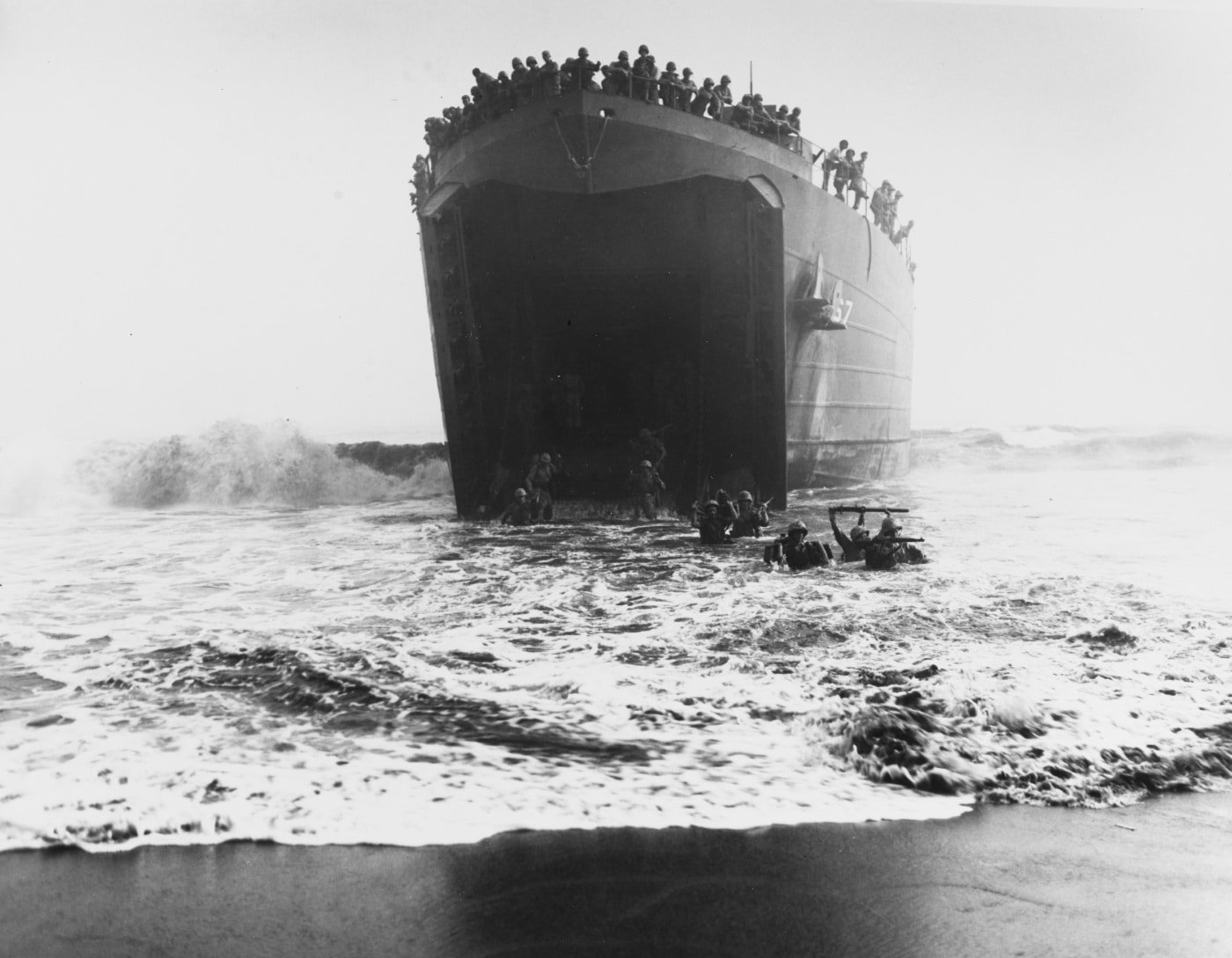
U.S. Marines wade through the surf and onto a beach during the Battle of Cape Gloucester. Codenamed Operation Backhander, the fighting would last for three miserable weeks. Image: U.S. Navy
Survivors of that first big American offensive against the Japanese in the Pacific needed the break.
They were exhausted, emaciated, under-nourished and malaria-ridden after their stand in the Solomons.
Regardless, Division Commander Major General William Rupertus pushed his weary veterans hard in a relentless training schedule.
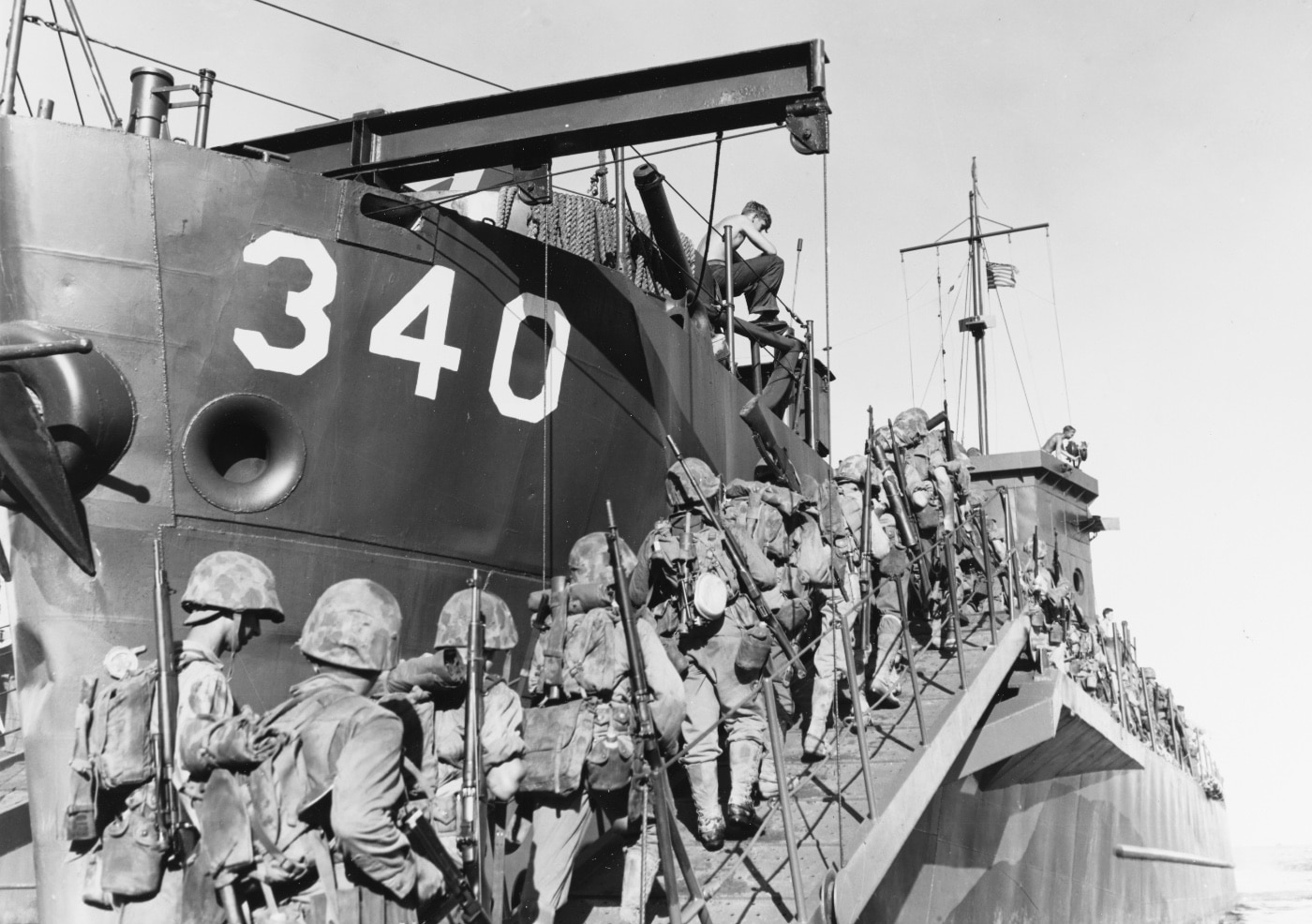
Marines board LCI-340 on Christmas Eve 1943 to liberate Cape Gloucester. Many men carry M1 Garand rifles. At the far left, a Marine carries a scope-equippedM1903A4 Springfield sniper rifle. Image: NARA
The landings were scheduled for 26 December.
Many were unhappy with MacArthurs plan and had argued vociferously against parts of it.
Even members of his own staff sided with the Marines objecting to that as a bridge too far.
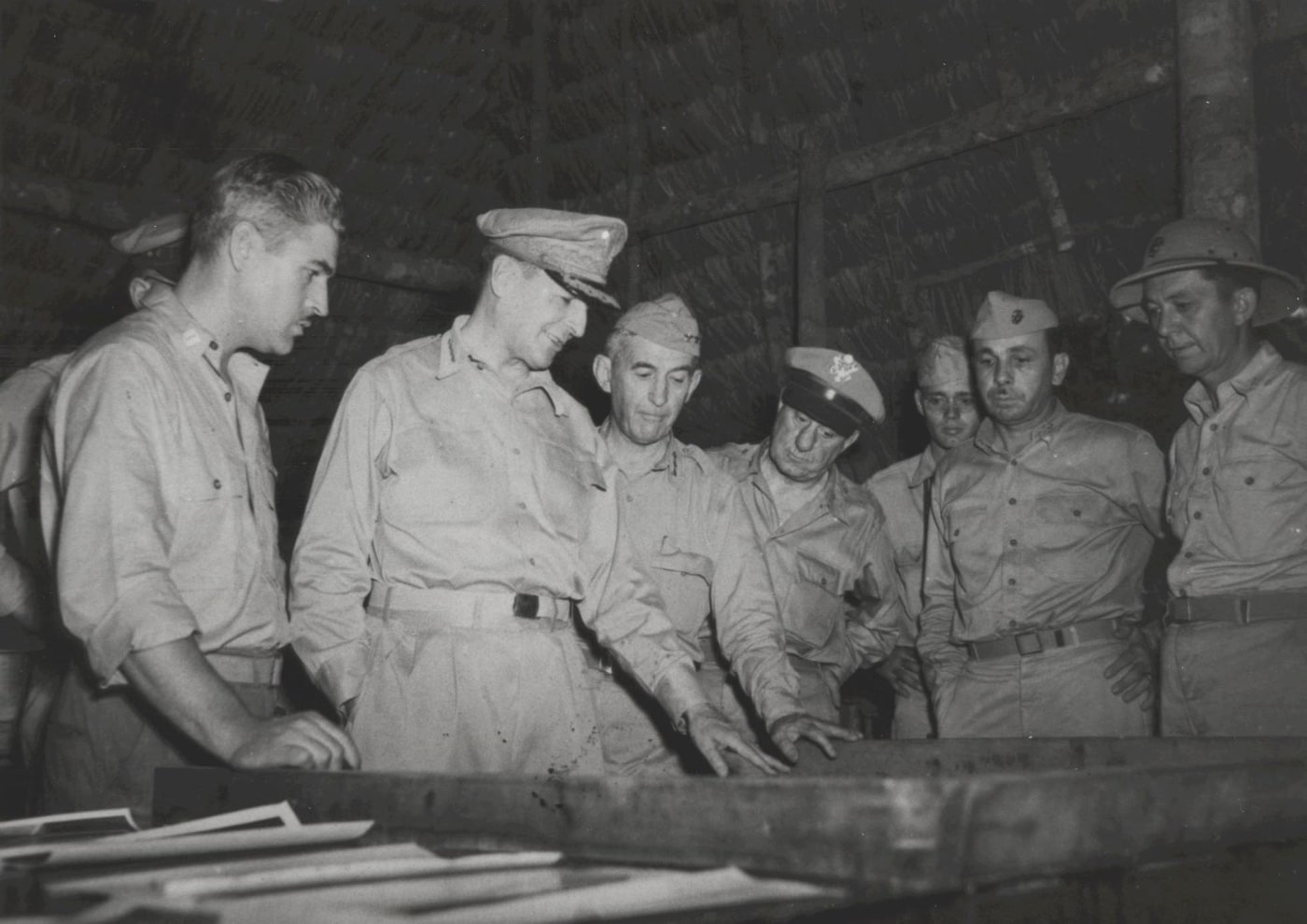
General Douglas MacArthur reviews plans for landing on Cape Gloucester. Richmond Dick Kelsey, a Walt Disney animator, made the relief map being used and stands on the far left of the photo. Image: U.S.M.C.
By this time in the war, pre-invasion landing preparations had become SOP.
It was the first clue to the difficulties the Marines would encounter once ashore at Cape Gloucester.
The winter monsoons had arrived at Cape Gloucester.

Brigadier General William H. Rupertus, center, on board USSNeville(AP-16) during combat operations in the Guadalcanal campaign. Gen. Rupertus would later be promoted to major general. Image: U.S. Navy
Despite deteriorating weather, the U.S. Army Air Corps managed to get flights of B-24s and B-25s into action.
Right off the landing craft, the Marines had to break out machetes and start hacking a path inland.
More machetes were added to the push inland, but still not much reaction from Japanese defenders.
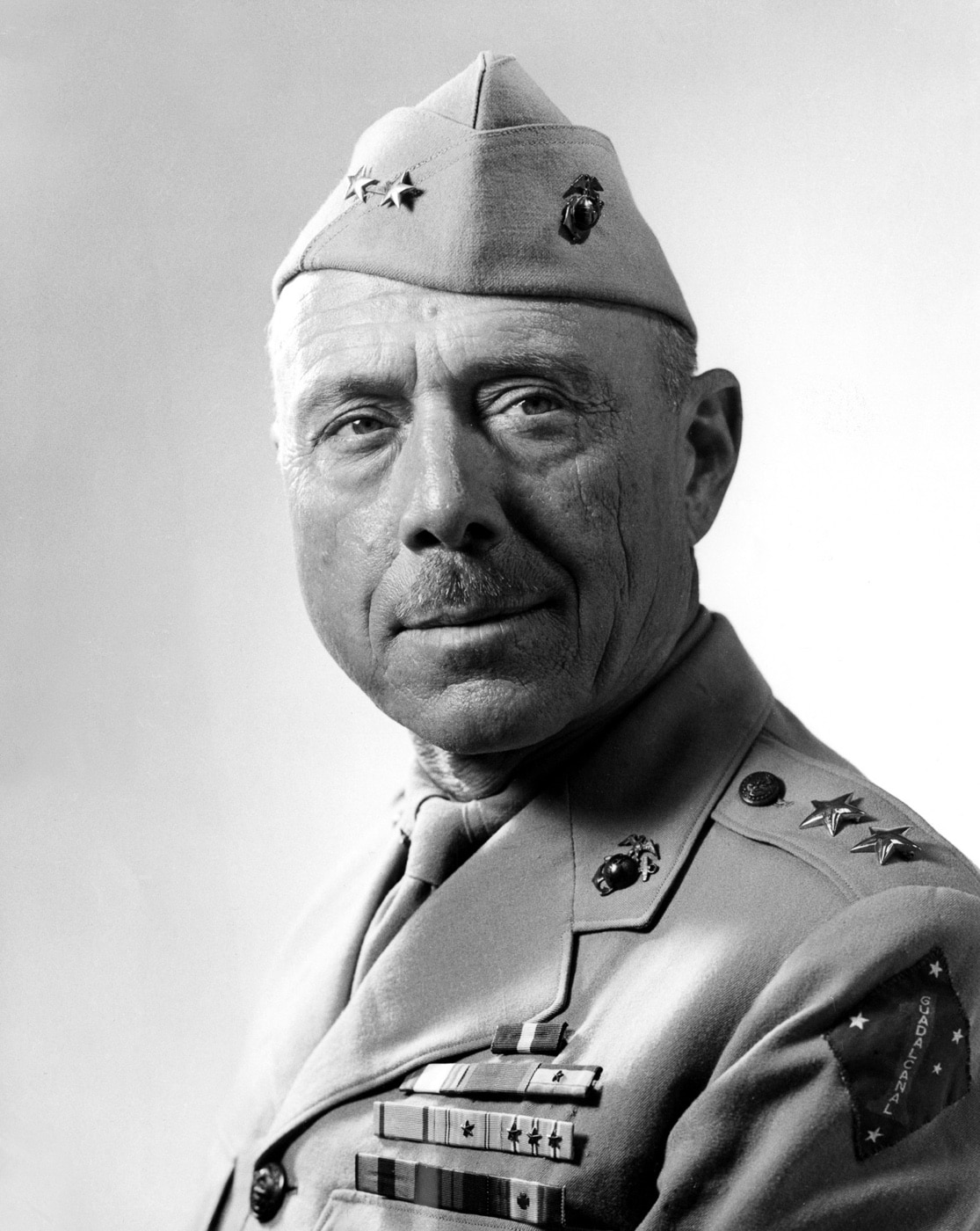
Maj. Gen. William H. Rupertus led the 1st Marine Division during the Battle of Cape Gloucester and theBattle of Peleliu. He also authored the U.S.M.C. Rifleman’s Creed. Image: NARA
Some of that was due to the sparse numbers of defenders around Cape Gloucester.
The Japanese had committed a scatter-shot unit to the defense of the central and western parts of New Britain.
They were nearly as hampered by weather and terrain as the assaulting Americans.
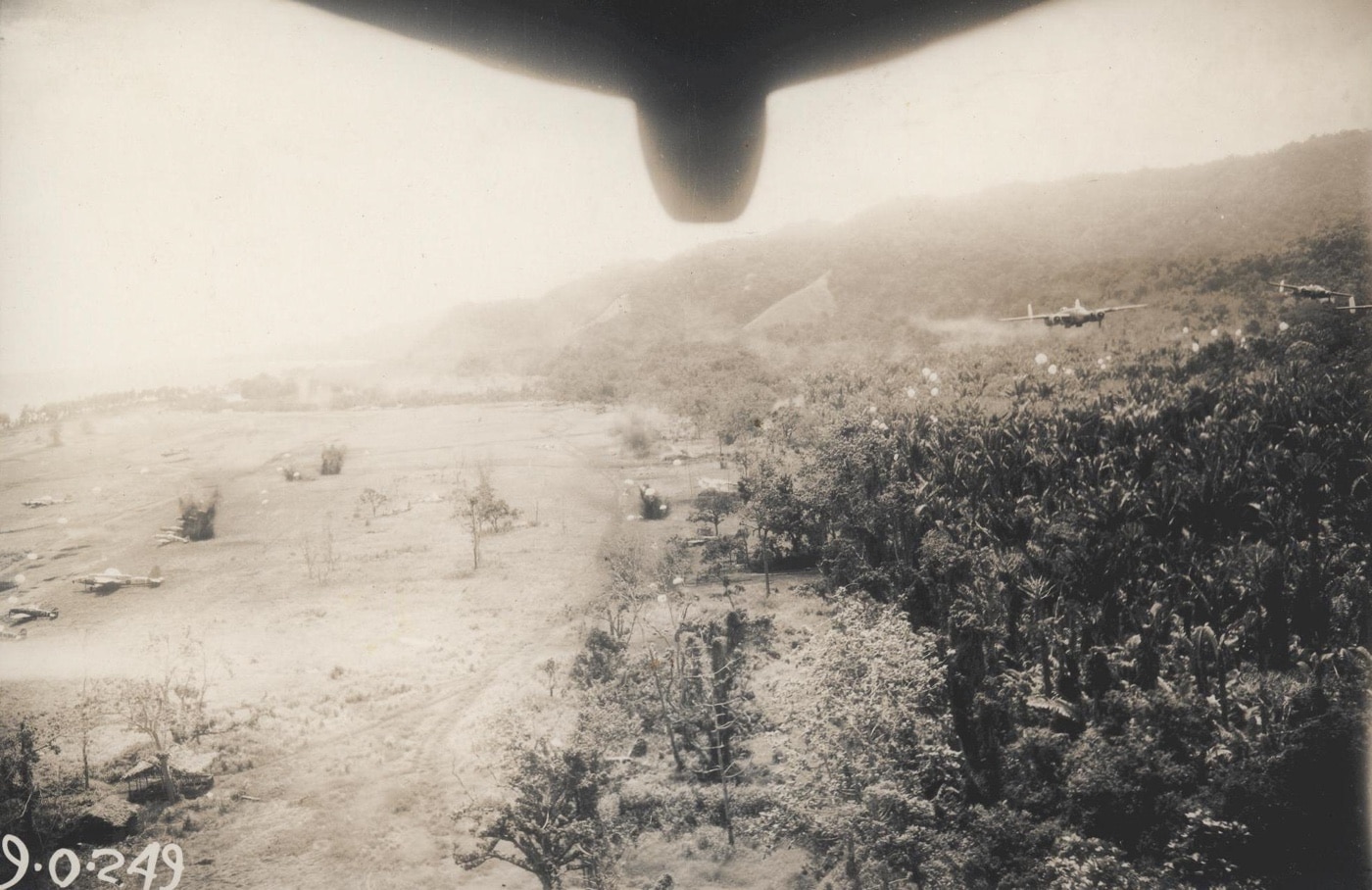
In a pre-landing attack, these North AmericanB-25 Mitchell bombershit the Japanese airfield on Cape Gloucester, December 1943. Image: U.S.M.C.
Much of his fighting strength was tied up defending in New Guinea or the northern Solomons.
Imamura had just a cobbled together 65thBrigade to cover all of New Britain.
An official report on conditions in and around Cape Gloucester was startling.
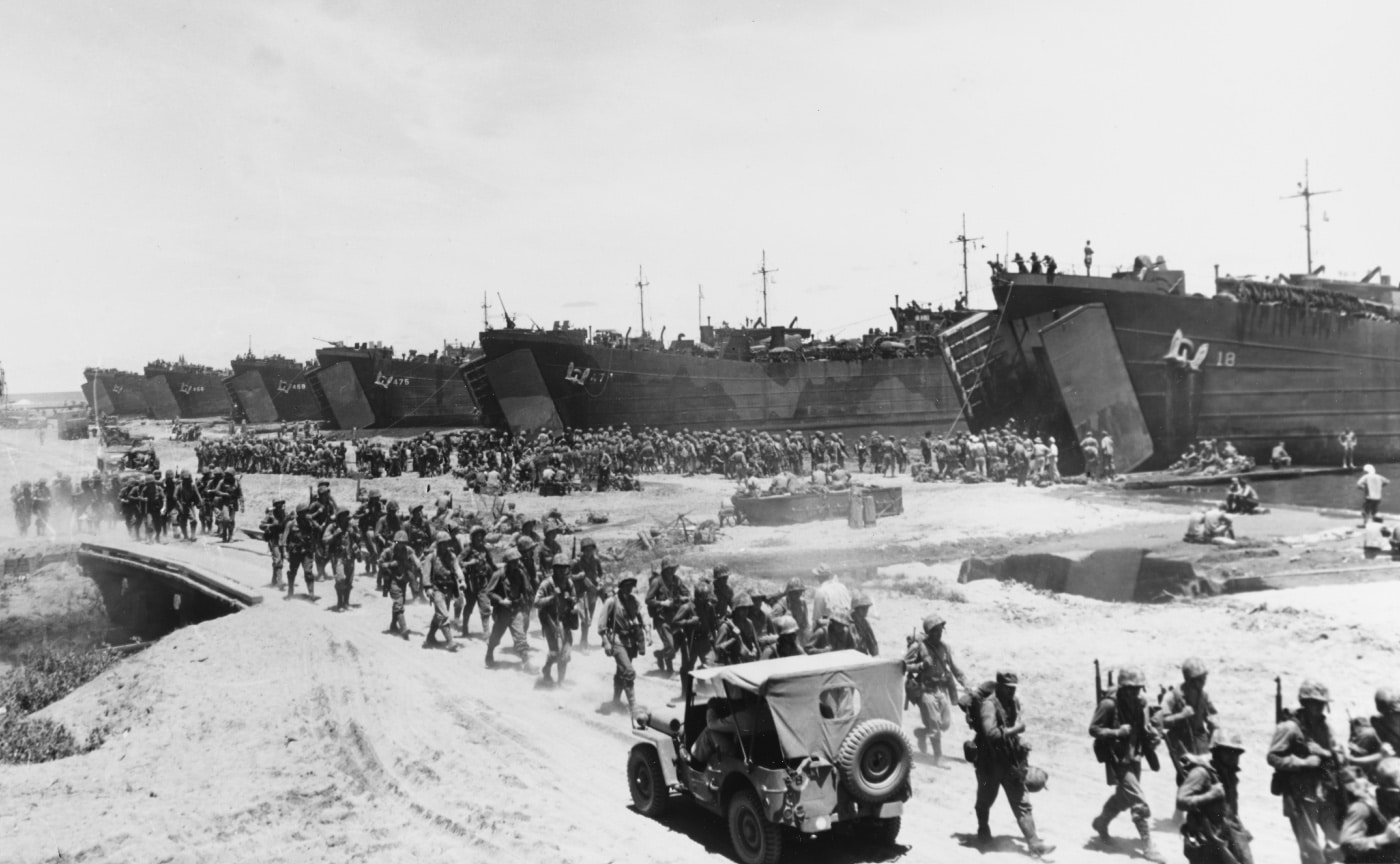
Marines load onto LSTs at Oro Bay, New Guinea on December 24, 1943. Two days later they would land on Cape Gloucester. Image: Brenner/U.S. Navy
That put the Japanese 53rdInfantry straddling the Marines axis of advance.
And things just got worse in a place that the Marines had started to call The Green Inferno.
Casualties from sprains or broken bones began to mount.
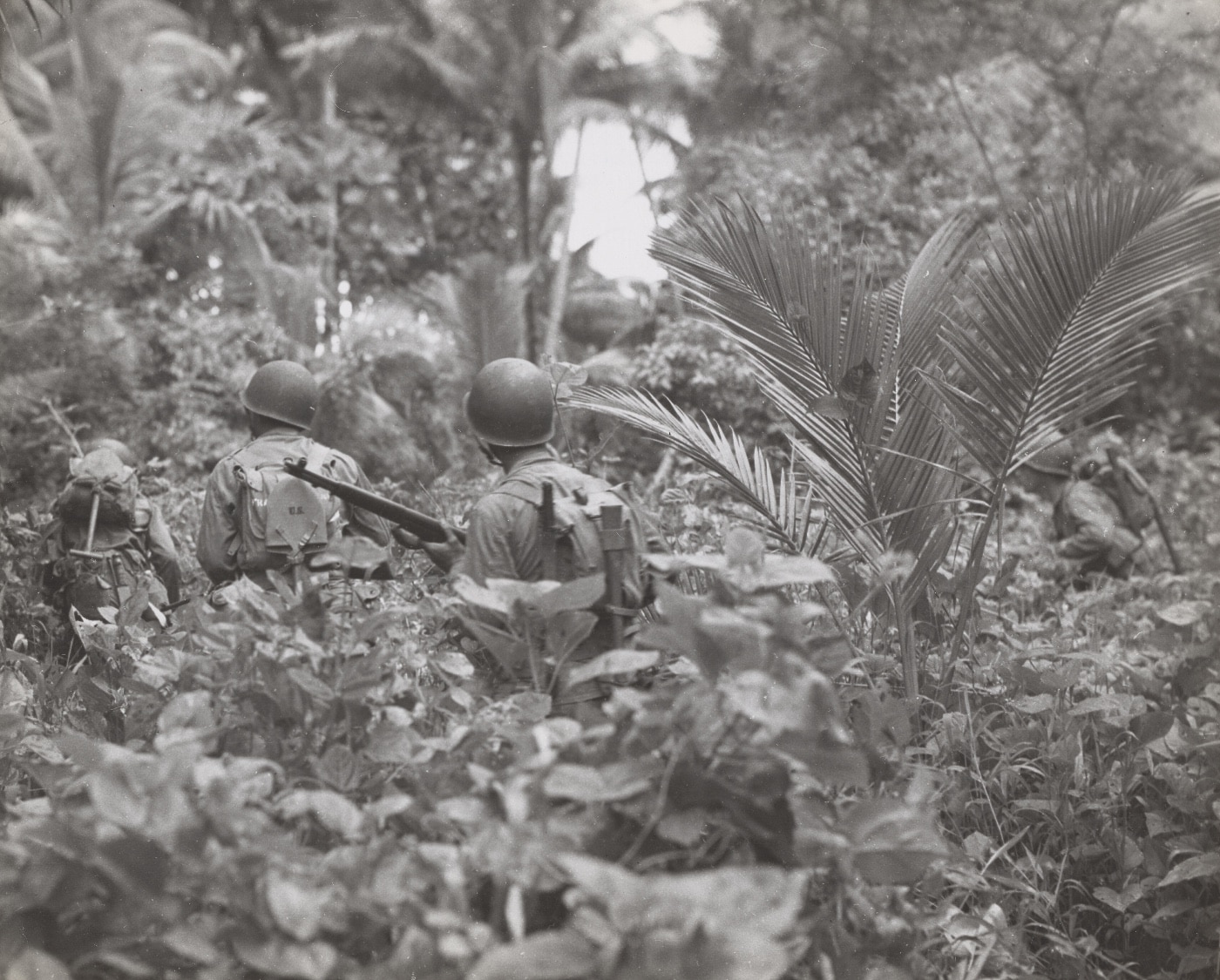
The U.S. Marines moved through mud and thick jungle to engage the Japanese. Image: Staff Sgt. James Carroll/U.S.M.C.
The first American casualty on Cape Gloucester was a Marine killed by a falling tree.
The 1st Battalion, 7thMarines finally reached a high-ground redoubt marked on maps as Target Hill.
They dug in to hold in marshy ground against repeated enemy counterattacks.
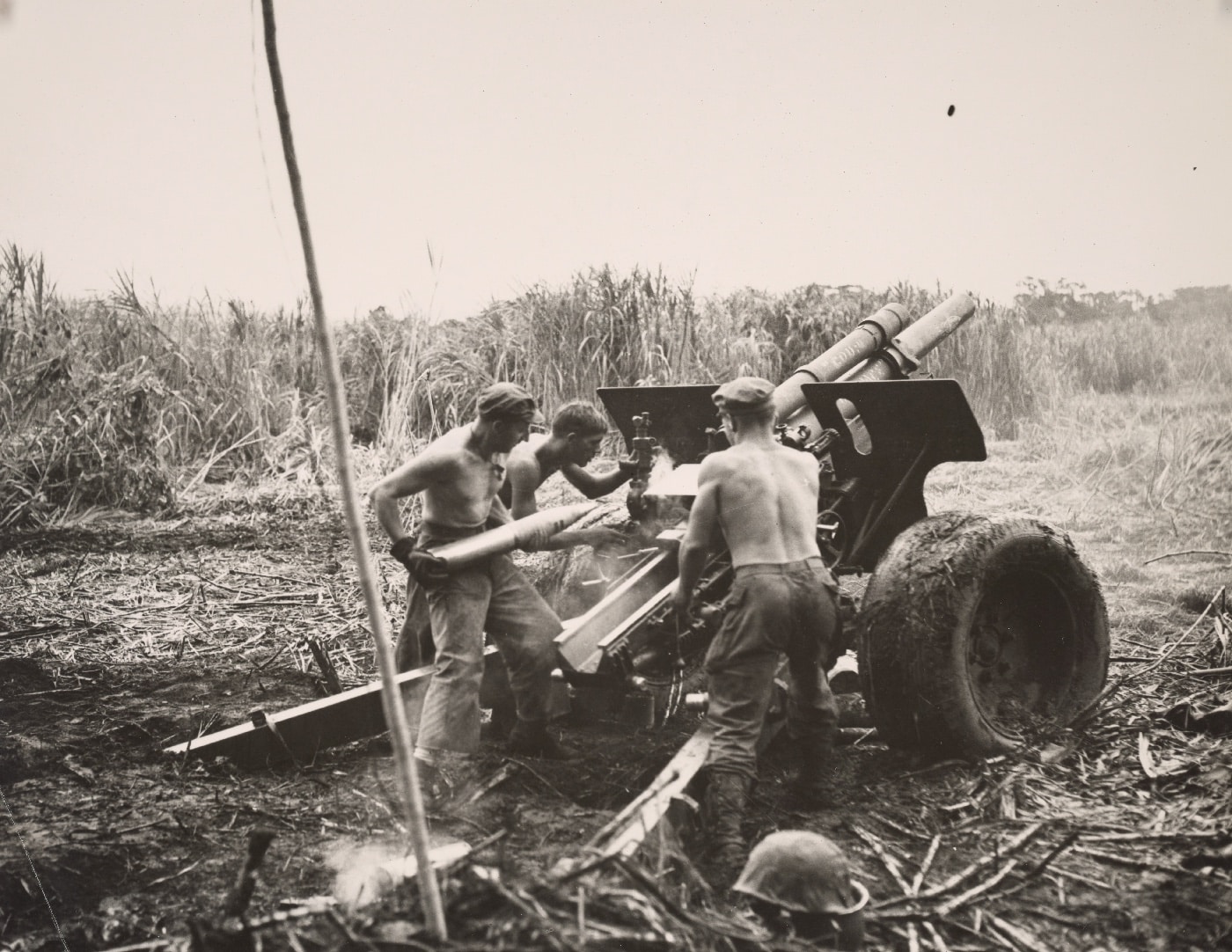
On the second day of the Battle of Cape Gloucester, these Marines fire their 105mm howitzer against the Japanese troops defending the airport. Image: NARA
Meanwhile, the 1stMarines were making their way toward the vital Japanese airfield.
Gunners couldnt get the weapons to ignite in the constant downpour.
That was the plan, but the artillerymen promptly ran into problems of their own.
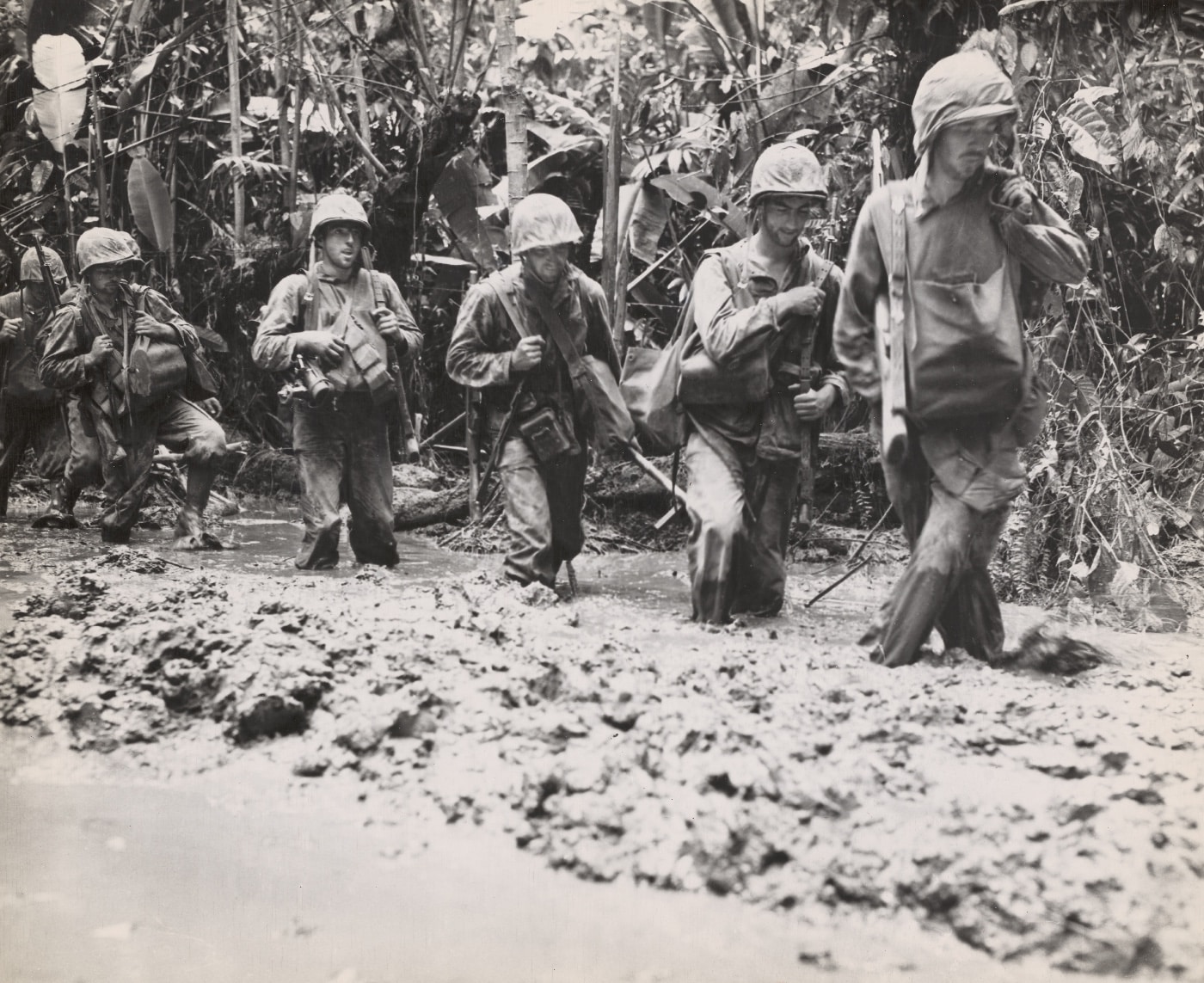
Mud like this was just one of the environmental hinderances the Marines had to overcome during the Battle of Cape Gloucester. Image: U.S.M.C.
The guns got bogged down before they could register to shoot.
It took a gaggle of AMTRACs and bulldozers to move the cannons forward into firing positions on semi-dry ground.
Early in the operation the weather gave both sides a break long enough to launch a few miserly airstrikes.
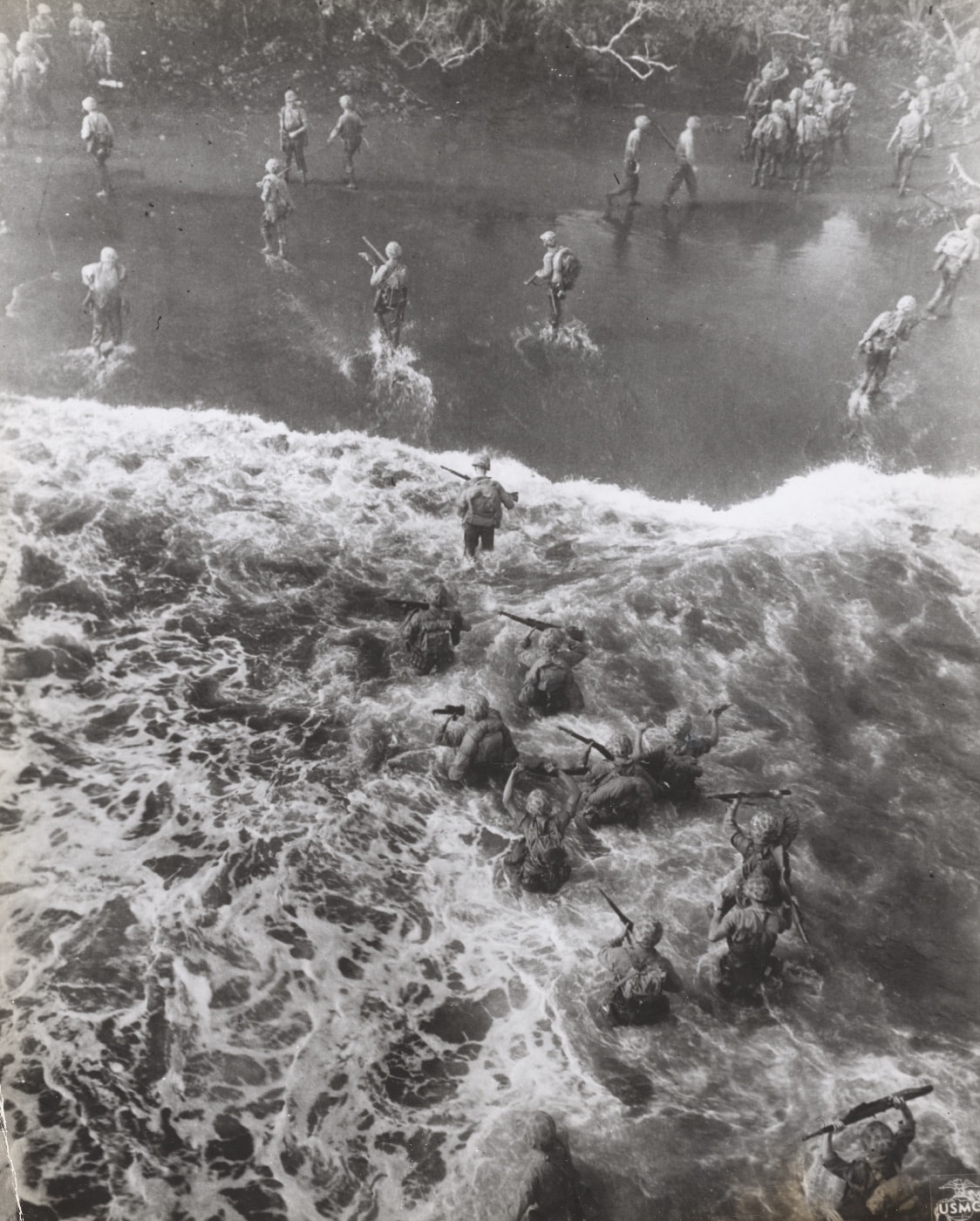
Carrying their rifles high, United States Marines wade through three-foot surf at Cape Gloucester from their LST. Image: Sgt. Robert M. Howard/U.S.M.C.
Army Air Corps B-25 bombers headed for New Britain on a bombing run in support of the Marines.
At some point over the landing sites, the two air forces tangled.
They managed to seriously damage a U.S. destroyer that later sank.
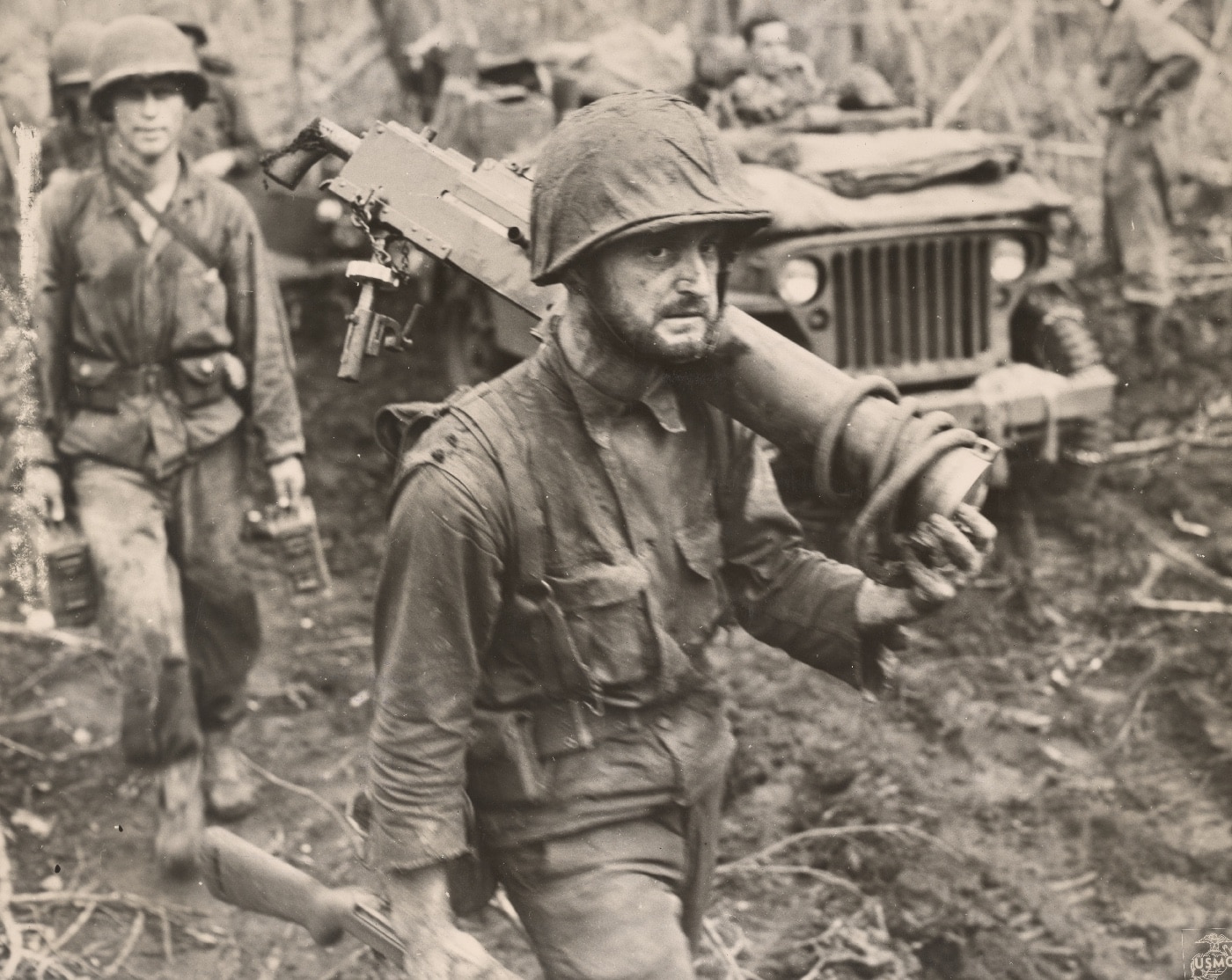
Pfc. George C. Miller carries a machine gun through the rain-soaked jungle on Cape Gloucester. He was returning from 19 days of heavy fighting on the front lines. Image: NARA
American Marines at Cape Gloucester continued to struggle forward while Japanese defenders put up stubborn resistance.
Hurricane-force winds blew in from offshore, bringing thunderstorms and lightning.
It was miserable for both sides.
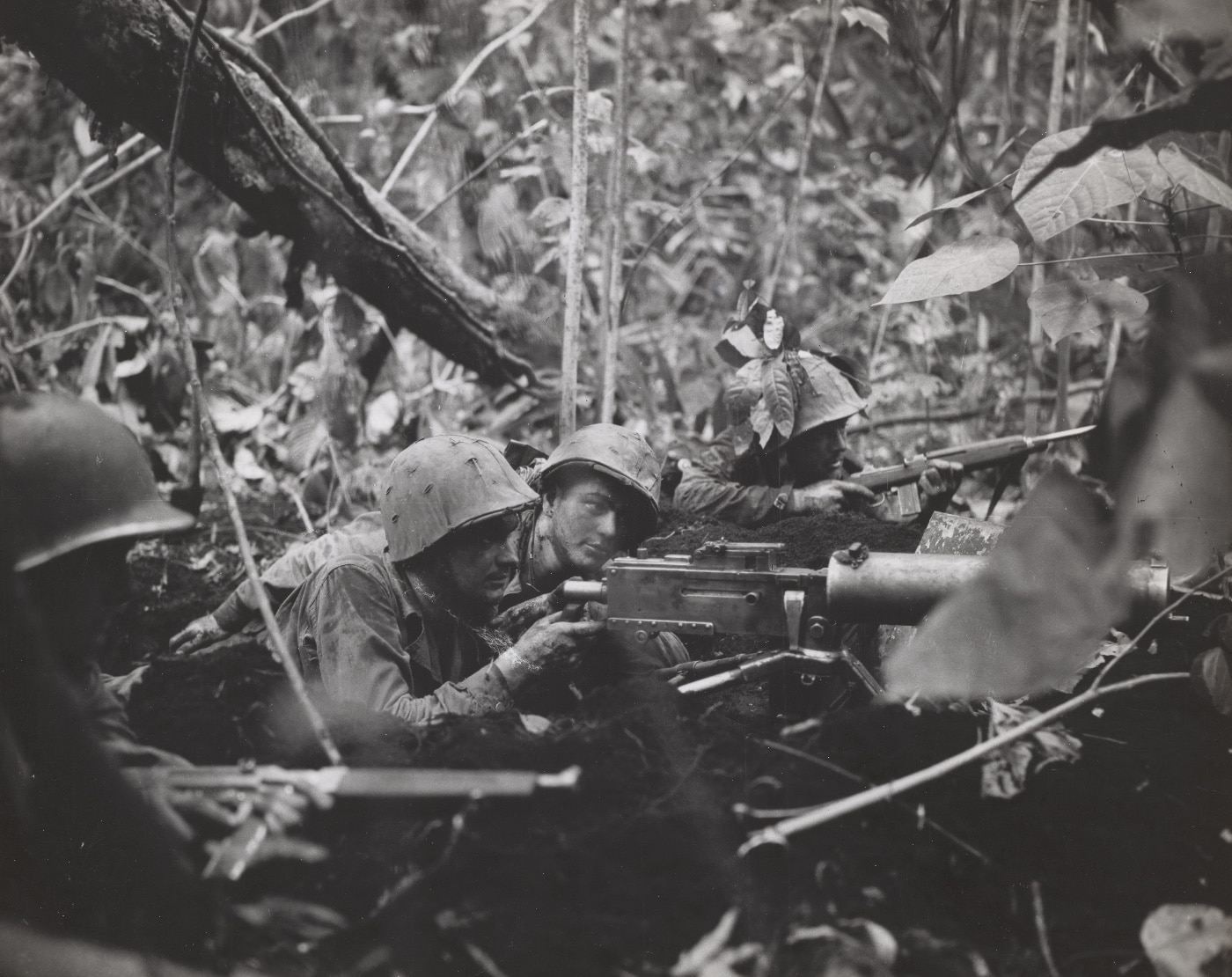
These Marines prepare to repel a Japanese counterattack. Two men run a M1917 Browning machine gun and are supported by Marines armed with anM1 Carbineand Thompson submachine gun. U.S.M.C.
Water backed up in the swamps has made terrain impassable except for amphibian tractors.
Streams that emptied into the sea have become raging torrents all along the route of advance toward the airfield.
Troops soaked to the skin, and their clothes never dried out during the entire operation.
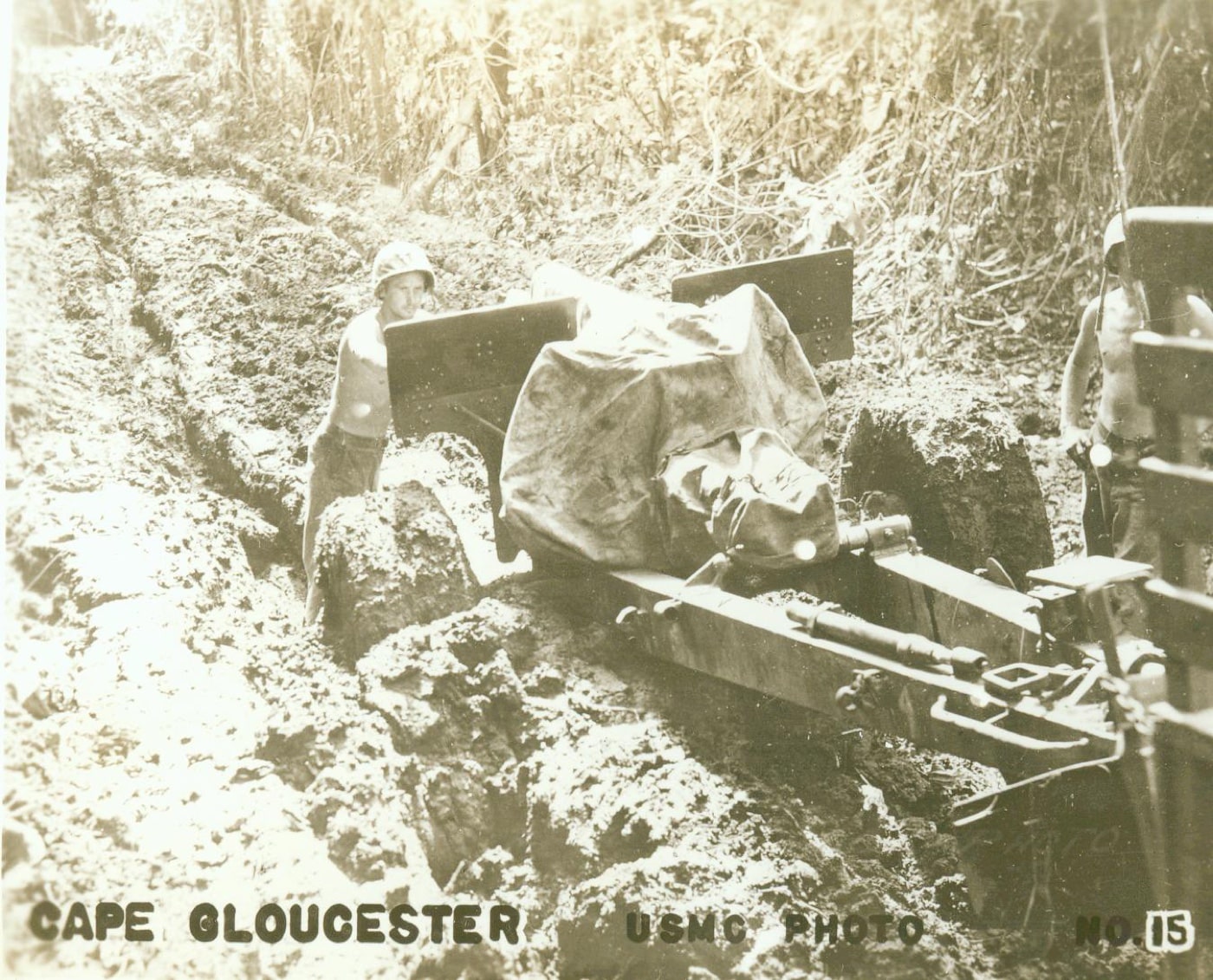
Miserable weather led to Marines fighting the mud as much as the Japanese on Cape Gloucester. Image: U.S.M.C.
Typically, the Japanese defenders of the 53rdInfantry decided it was a perfect time for an all-out banzai attack.
Soaked weapons caked with mud misfired.
The Crown Jewel
General Rupertus was not a patient man.
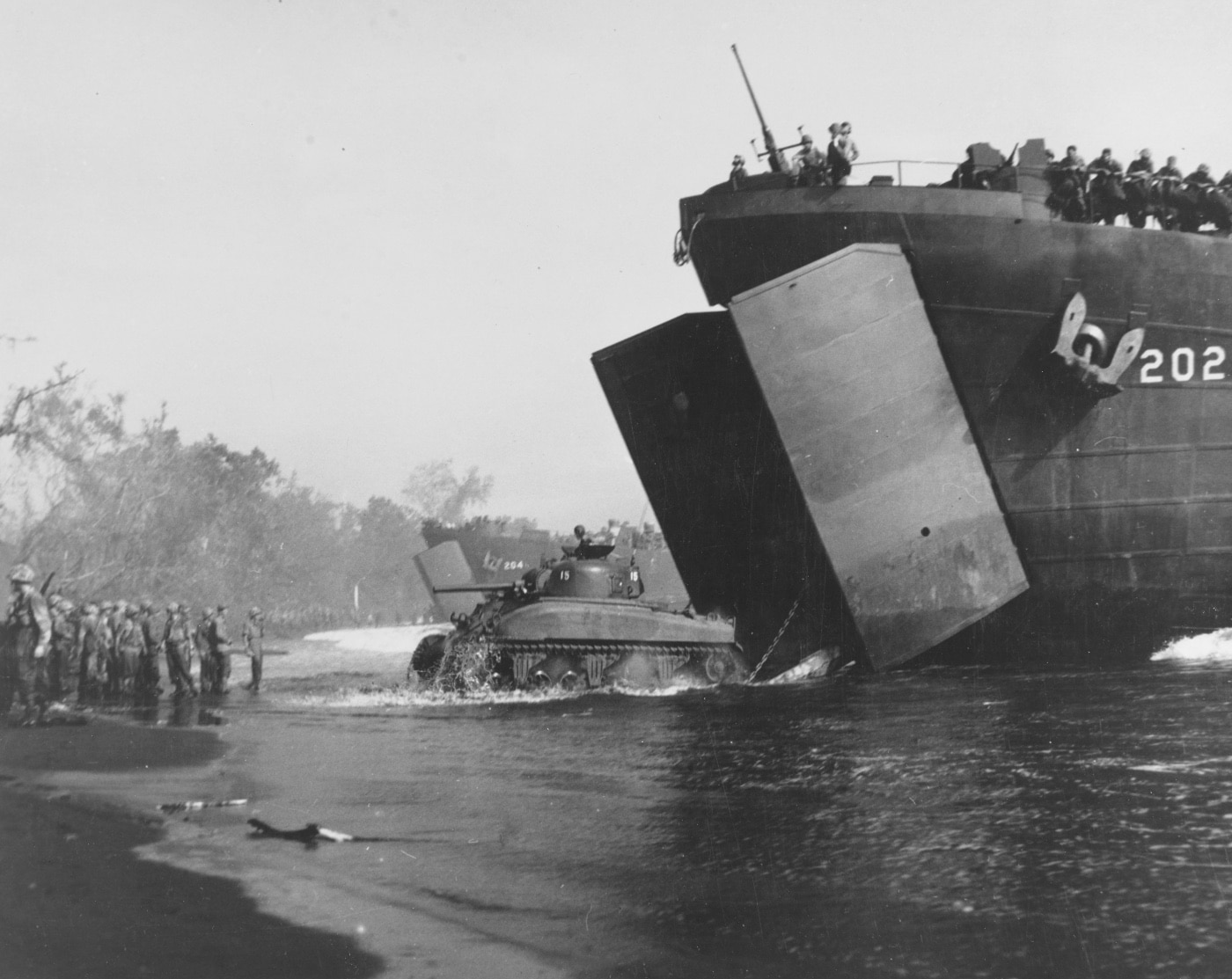
An M4 Sherman tank of the 1st Marine Division rolls off LST-202 at Cape Gloucester. The Sherman tanks proved valuable during the operation. Image: U.S. Navy
Rupertus pushed two battalions of the 1stMarines into the advance reinforced by all the tanks he could muster.
The Japanese 75mm cannon in those bunkers proved ineffective against the Shermans backed by riflemen.
The Marines killed some 300 defenders in the fight.
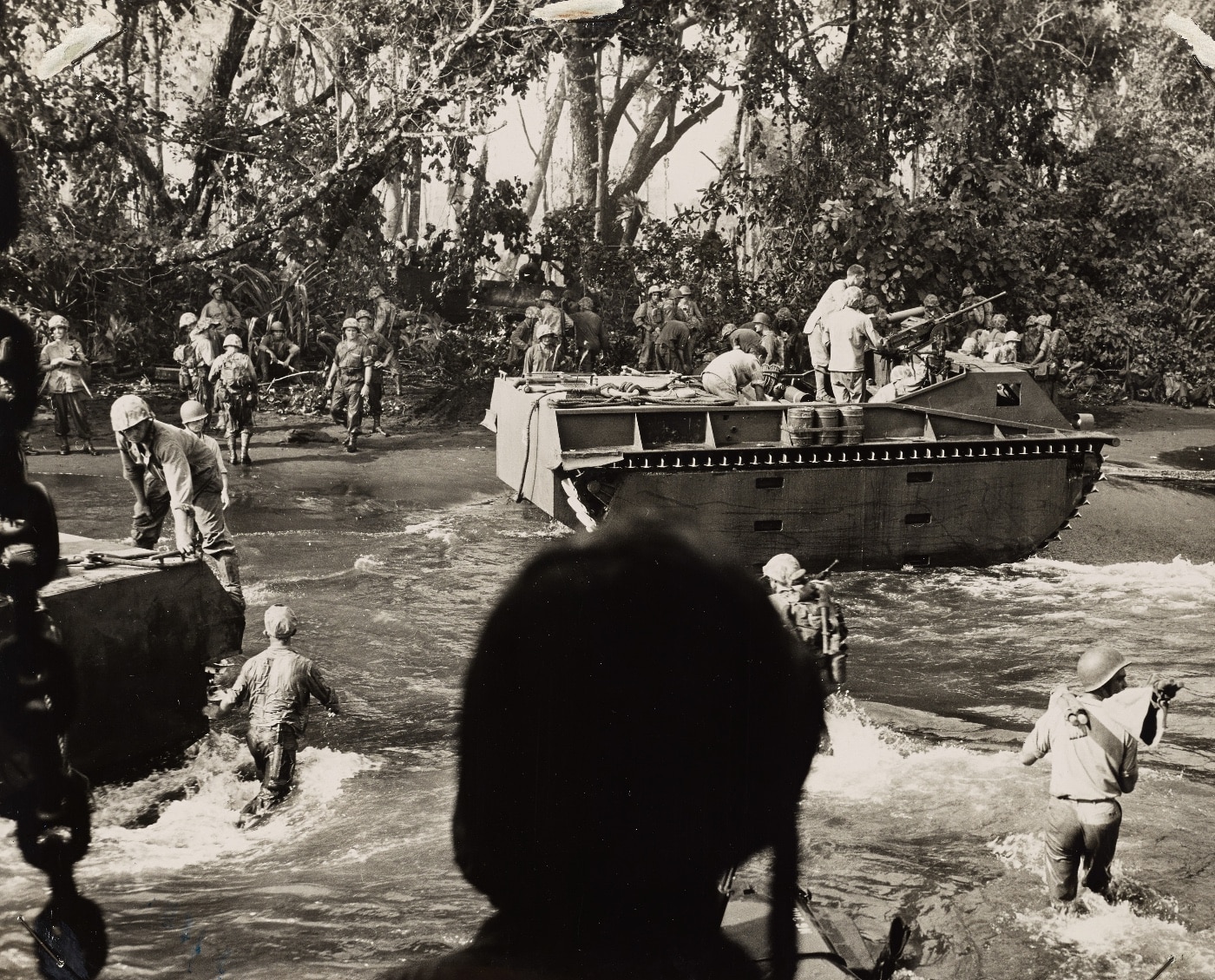
This amphibious tractor, or AMTRAC, is used to pull heavy fighting equipment through the surf. Officially known as the Landing Vehicle Tracked, LVTs were based on theRoebling Alligator. Image: NARA
With that defensive line penetrated, Rupertus could mass for a concerted move on the enemy airfield.
Thats when the 1stMarine Division caught a valuable break.
A patrol ran onto a lone Japanese soldier buried up to his neck in thick mud.
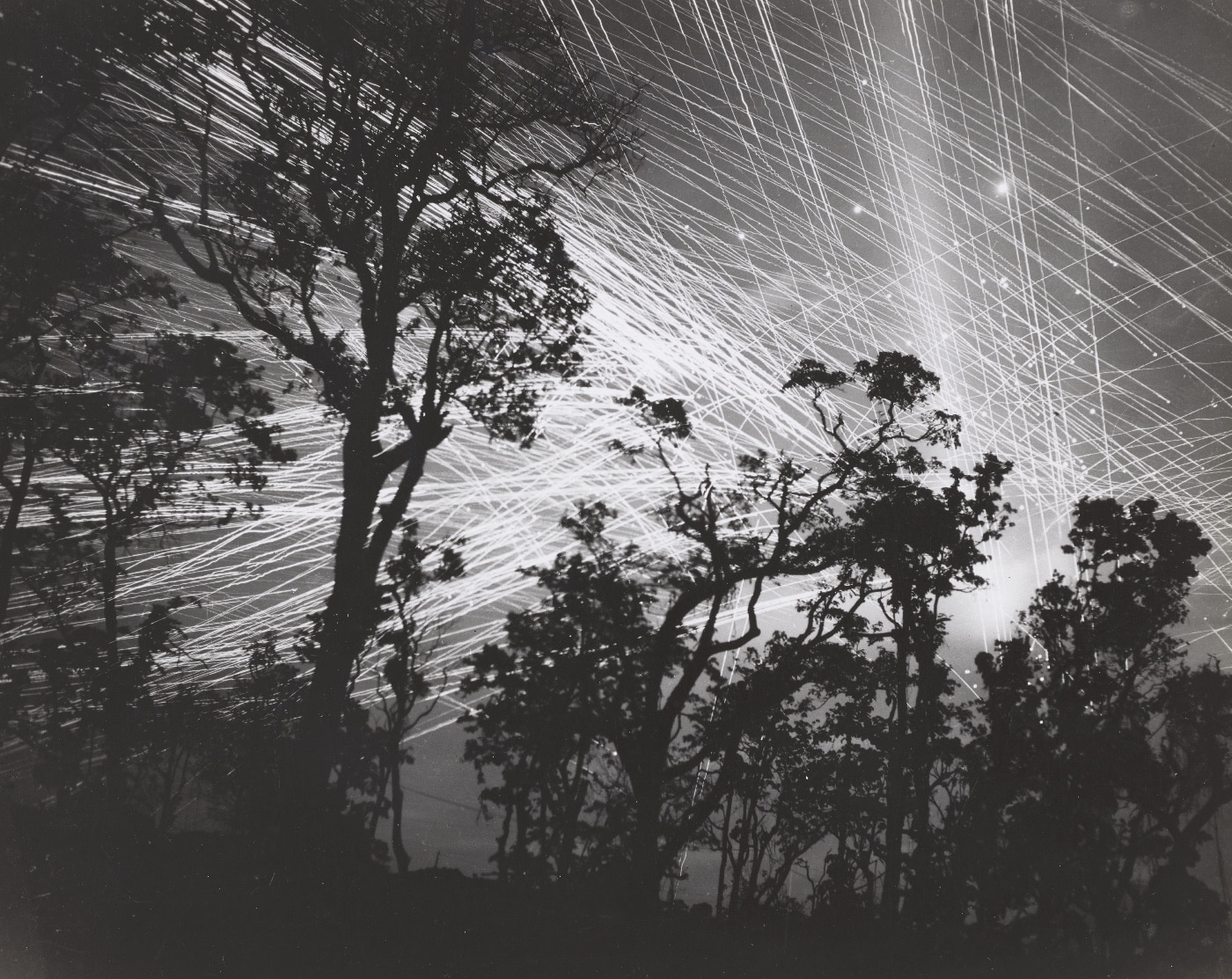
During the fighting on Cape Gloucester, Japanese bombers attempted to sneak in under the cover of night. Anti-aircraft tracer fire sent up by Marines stood out against the black night sky. Image: U.S.M.C.
This survivor turned into a goldmine of valuable intelligence.
What defense they put up against the final push to capture the airfield was lackluster, at best.
Backed by tanks and hub-to-hub artillery batteries, the Marines pushed through a tangled rainforest.
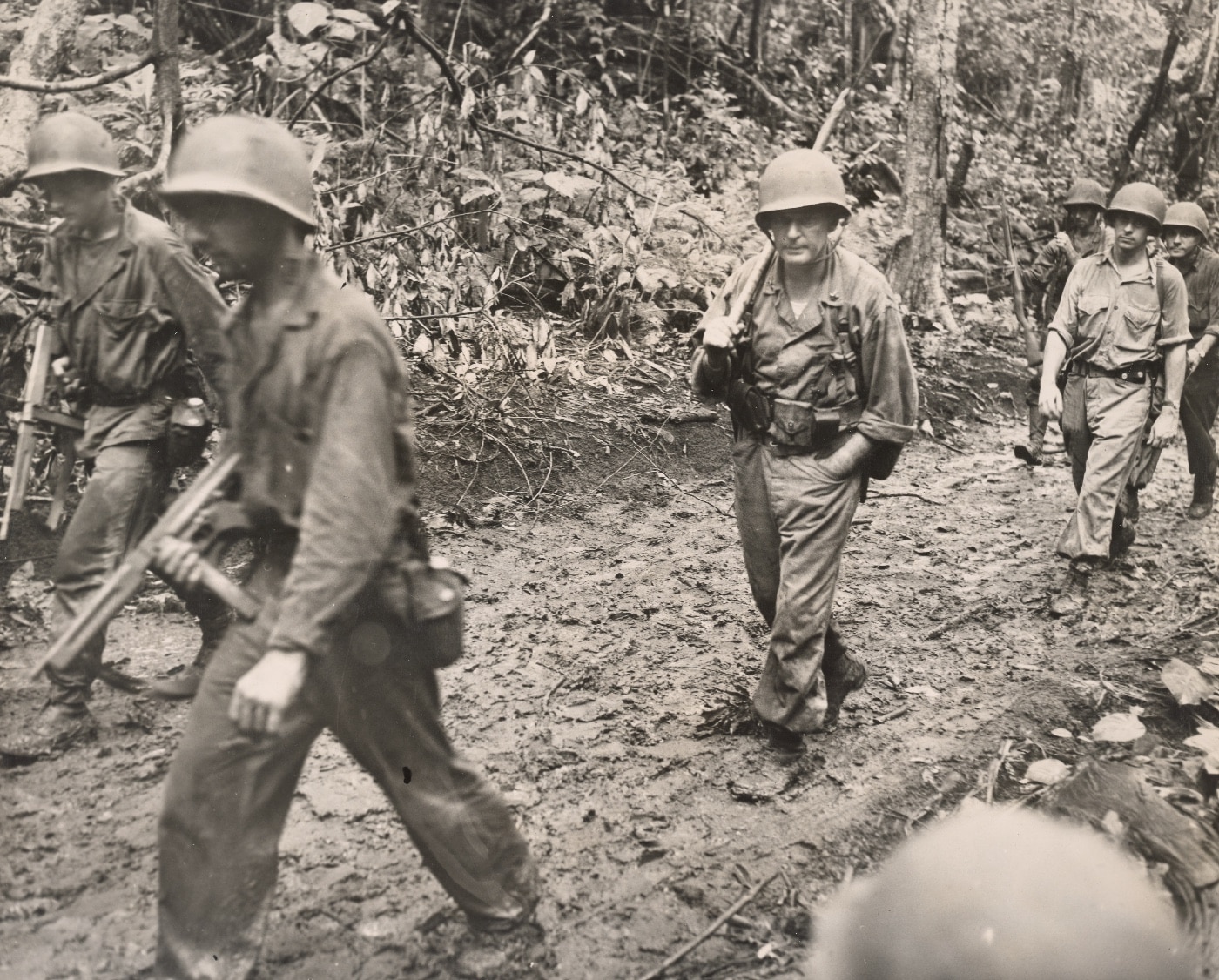
A decorated combat veteran of World War I, Brig. Gen. Lemuel C. Shepherd, Jr. liked to be where the action was. Here, he moves along a muddy road with his Marines on Cape Gloucester. Image: NARA
That breathed new life into the weary, soaked Marines who advanced with vigor behind tanks and AMTRACs.
When the 5thMarines arrived shortly thereafter, the situation was well in hand.
As usual in operations in the Pacific, the Japanese refused to concede defeat.
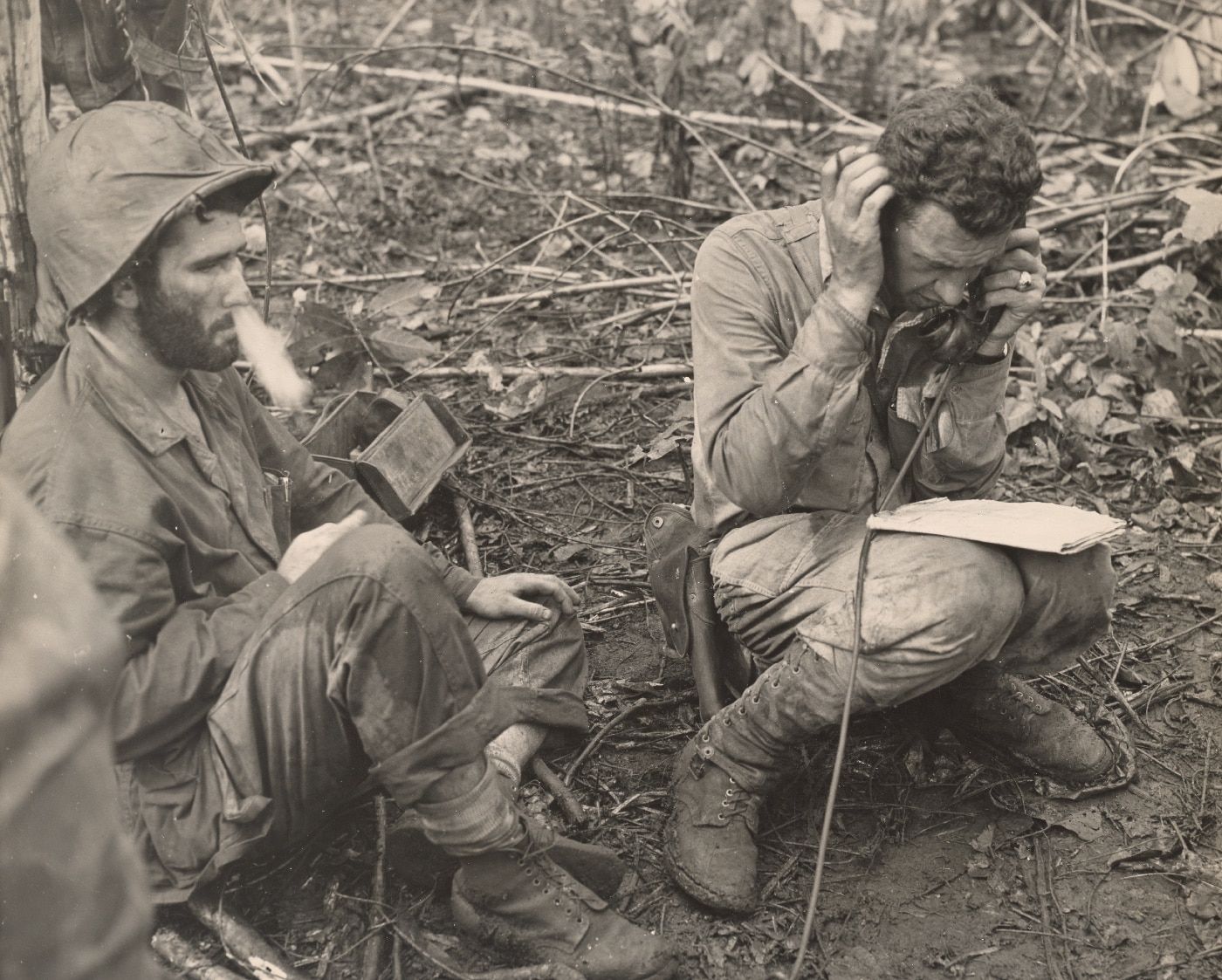
Lt. Col. John E. Weber, commanding officer of a Marine battalion on Cape Gloucester, sits on his helmet to receive a report from one of his company commanders. Image: NARA
Fighting at Suicide Creek on 2 January was less straightforward.
Advancing Marines ran into a deeply entrenched Japanese outfit guarding positions near a rain-swollen waterway.
Most of it was similar in nature.
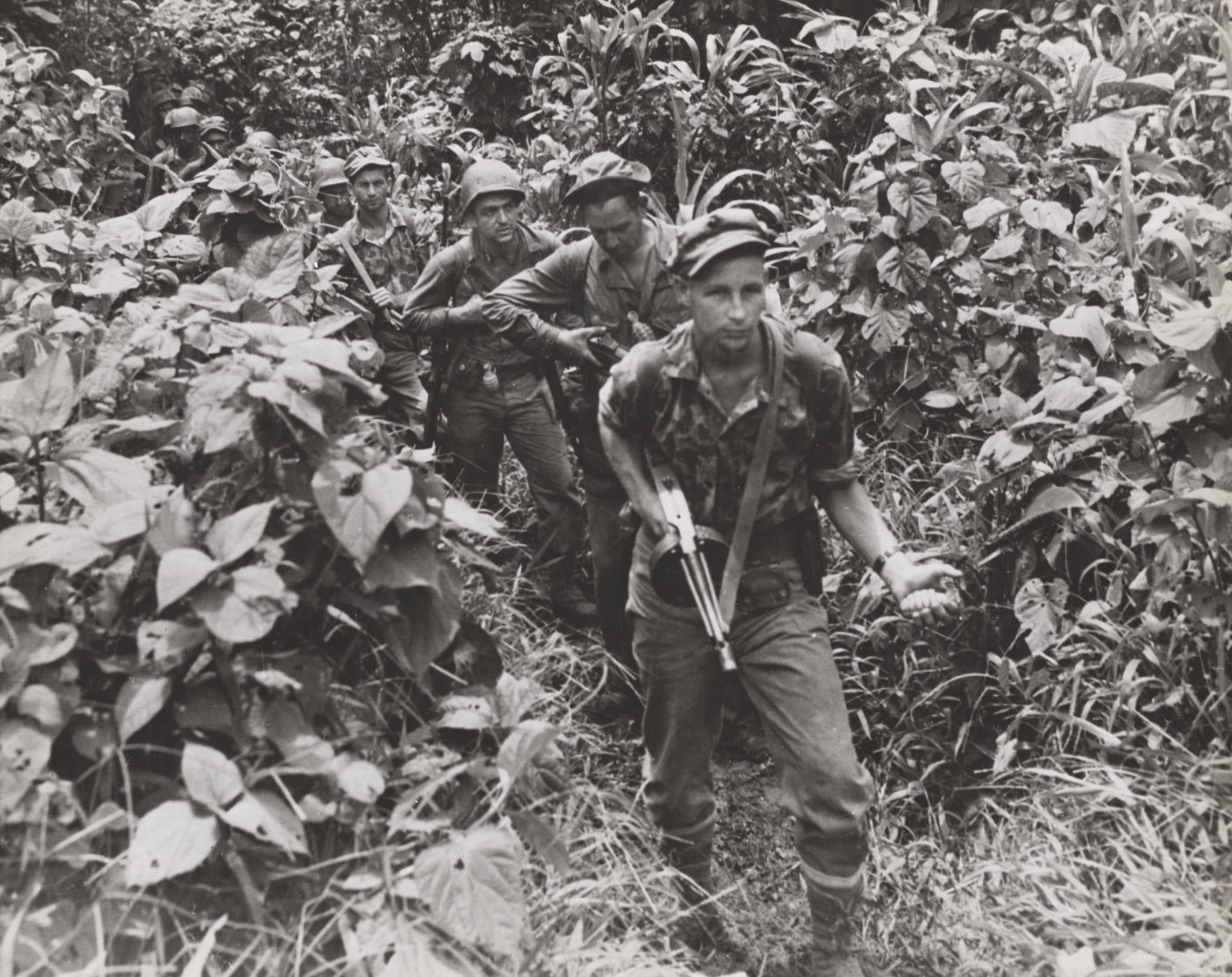
This Marine patrol pushes inland, pressuring Maj. Gen. Iwao Matsuda and his forces during the Cape Gloucester campaign. The patrol leader carries a Thompson M1A1 submachine gun. Image: U.S.M.C.
The Japanese attacked over sodden ground against Marines who defended from waterlogged fighting holes or the other way around.
Japanese General Matsuda issued orders for his remaining 1,100 troops to fall back toward Rabaul.
The Right Strategy?
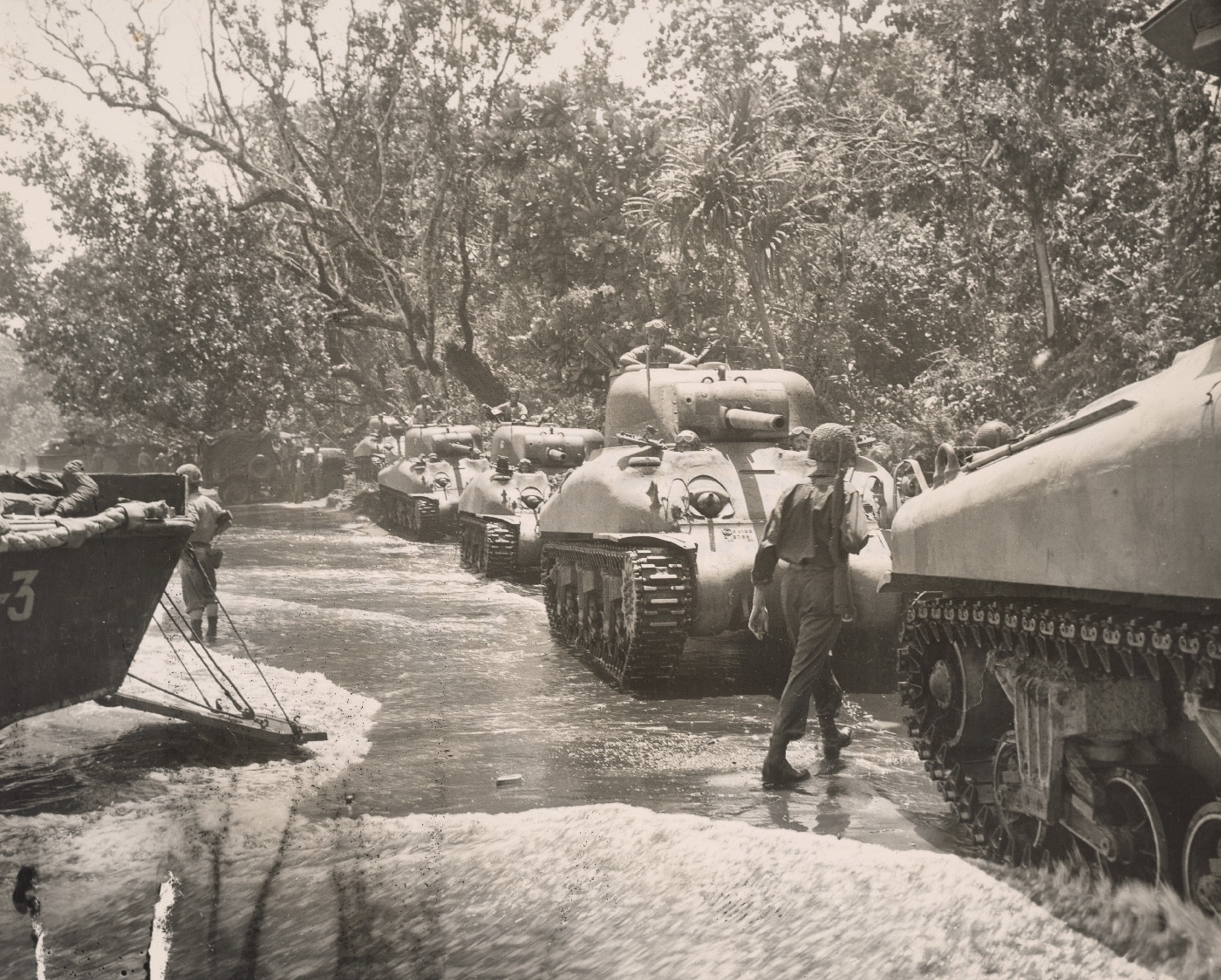
M4 Sherman tanks arrive in force on Cape Gloucester. They were essential for the push to capture the Japanese airfield. Image: NARA
Despite the horrid conditions they faced, Marine viewed it from a more positive angle.
Operation Dexterity taught them some valuable lessons that paid dividends later in the Pacific war.
And there were a lot of those after action on New Britain.
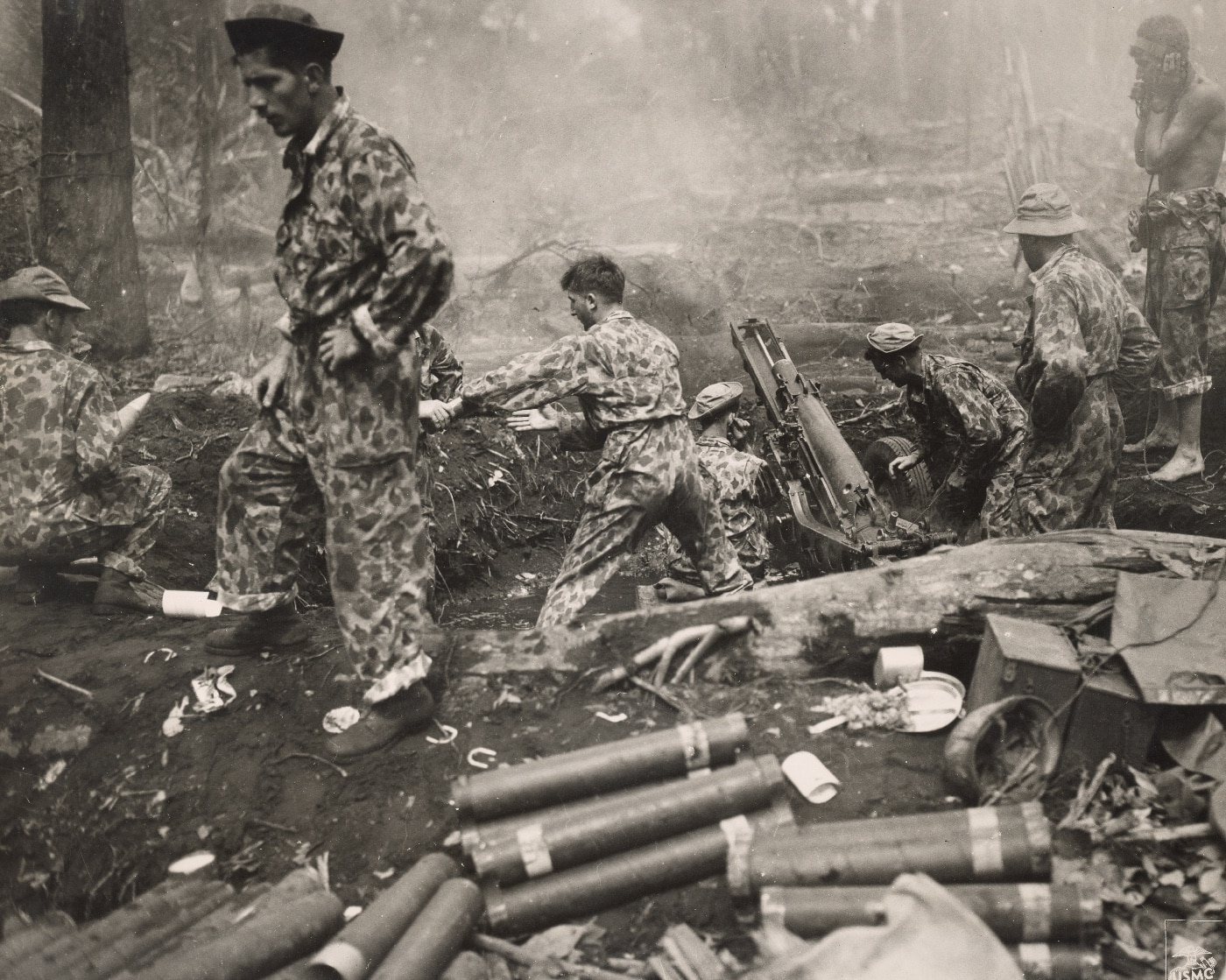
Marines pass ammunition to the M116 howitzer crew during a fire mission on Cape Gloucester. Image: NARA
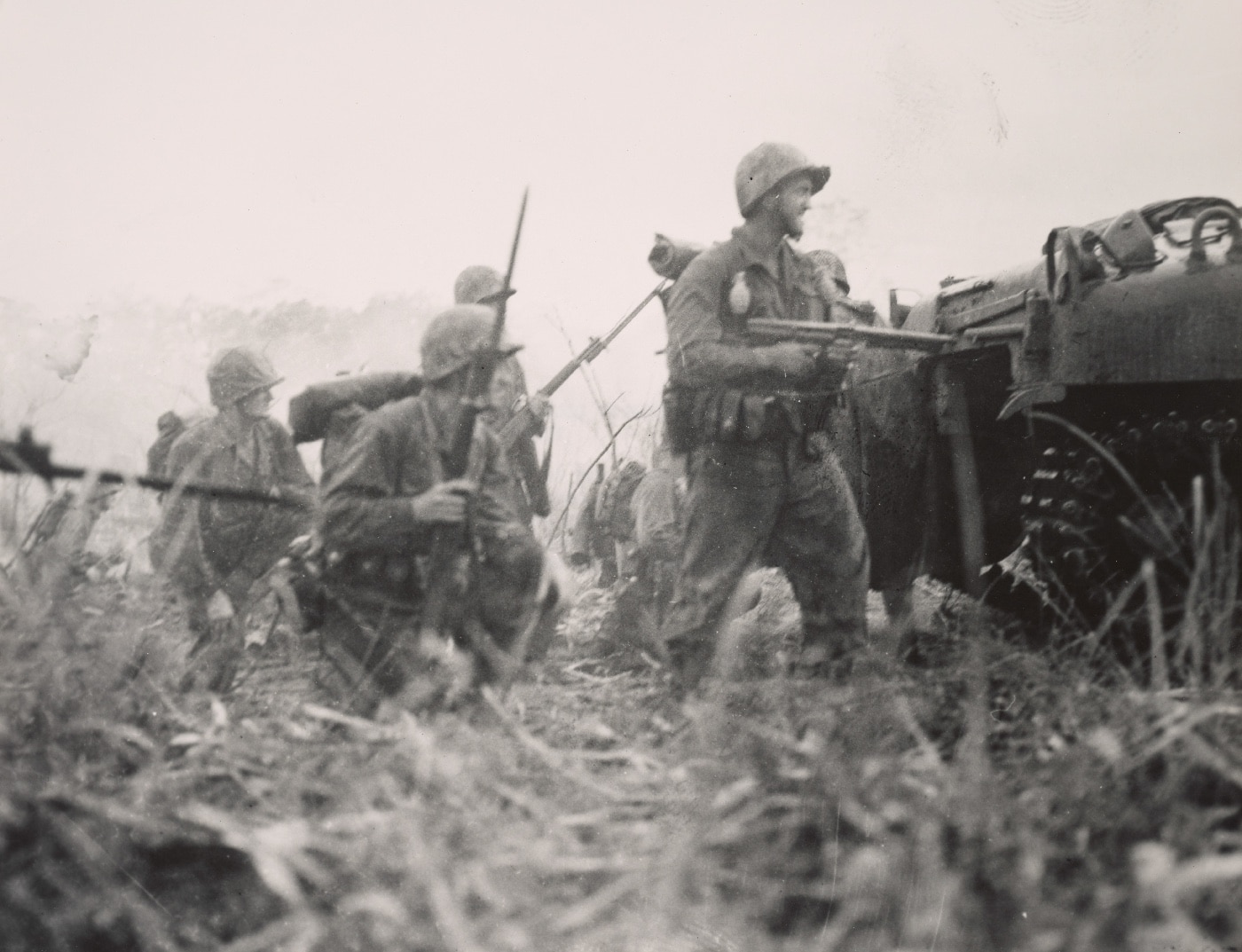
Marines follow Sherman tanks in an attack on Cape Gloucester’s airport. The Marine in front carries a Thompson SMG and has grenades at his shoulders where he can reach them in a hurry. Image: NARA
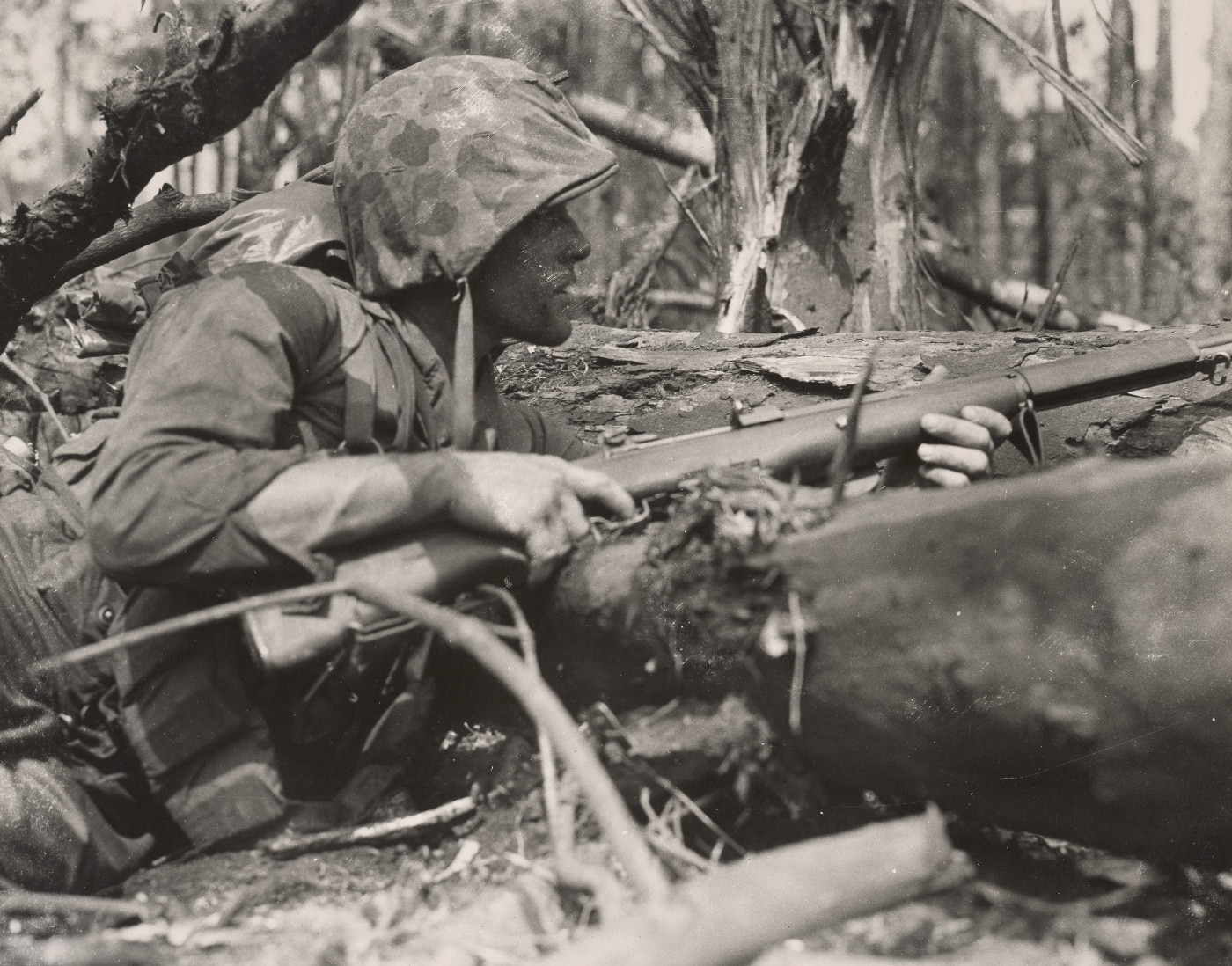
Pfc. Kenneth C. Crowley crouches behind a log on the first day of action on Cape Gloucester. Minutes after this photo was taken, he advanced with his unit and knocked out a Japanese pillbox. Image: NARA
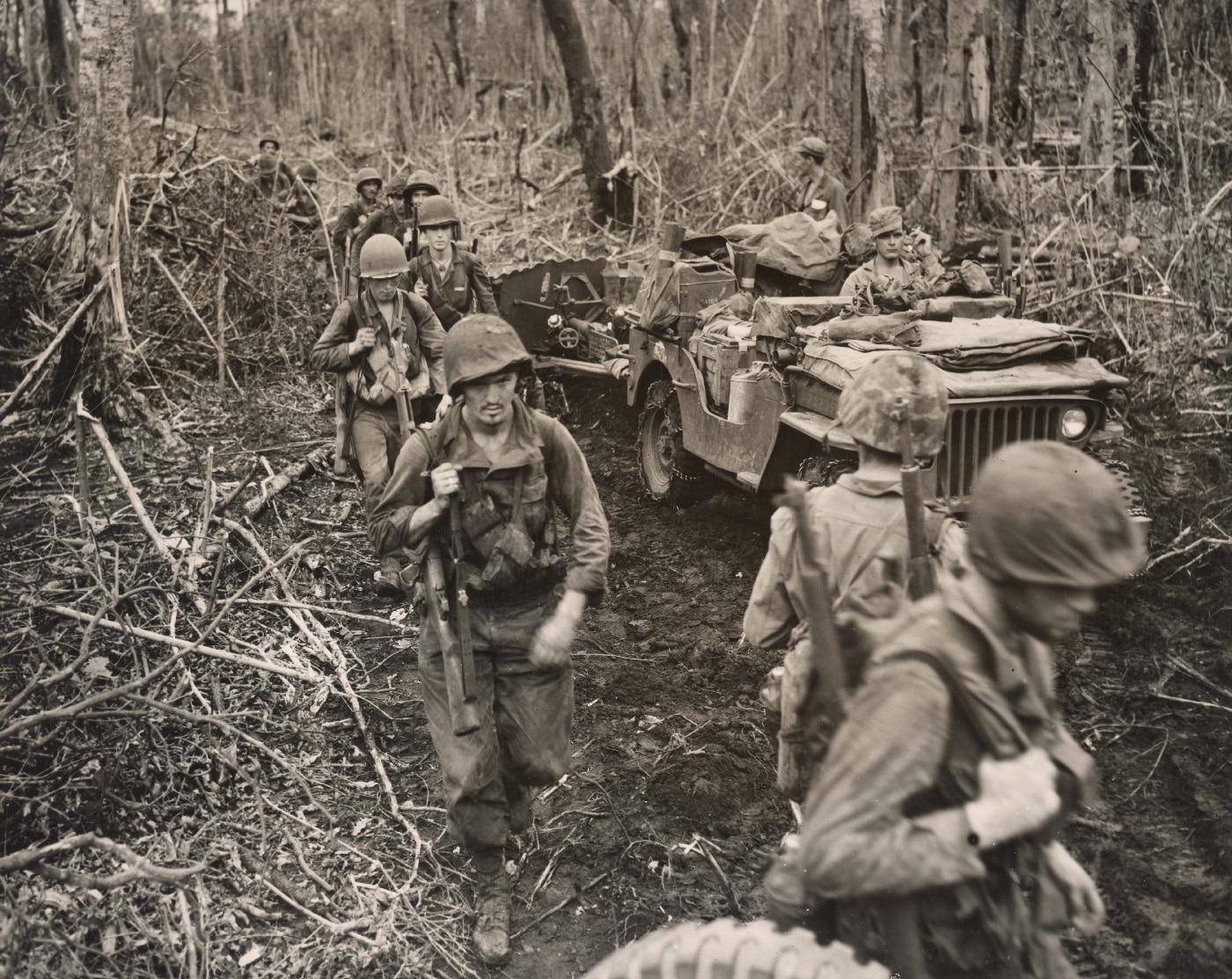
After 23 days of fighting, weary Marines move off the front line for a rest. A Jeep hauls a smaller artillery piece. The jeep’s tires have chains to improve its traction in the mud. Image: NARA
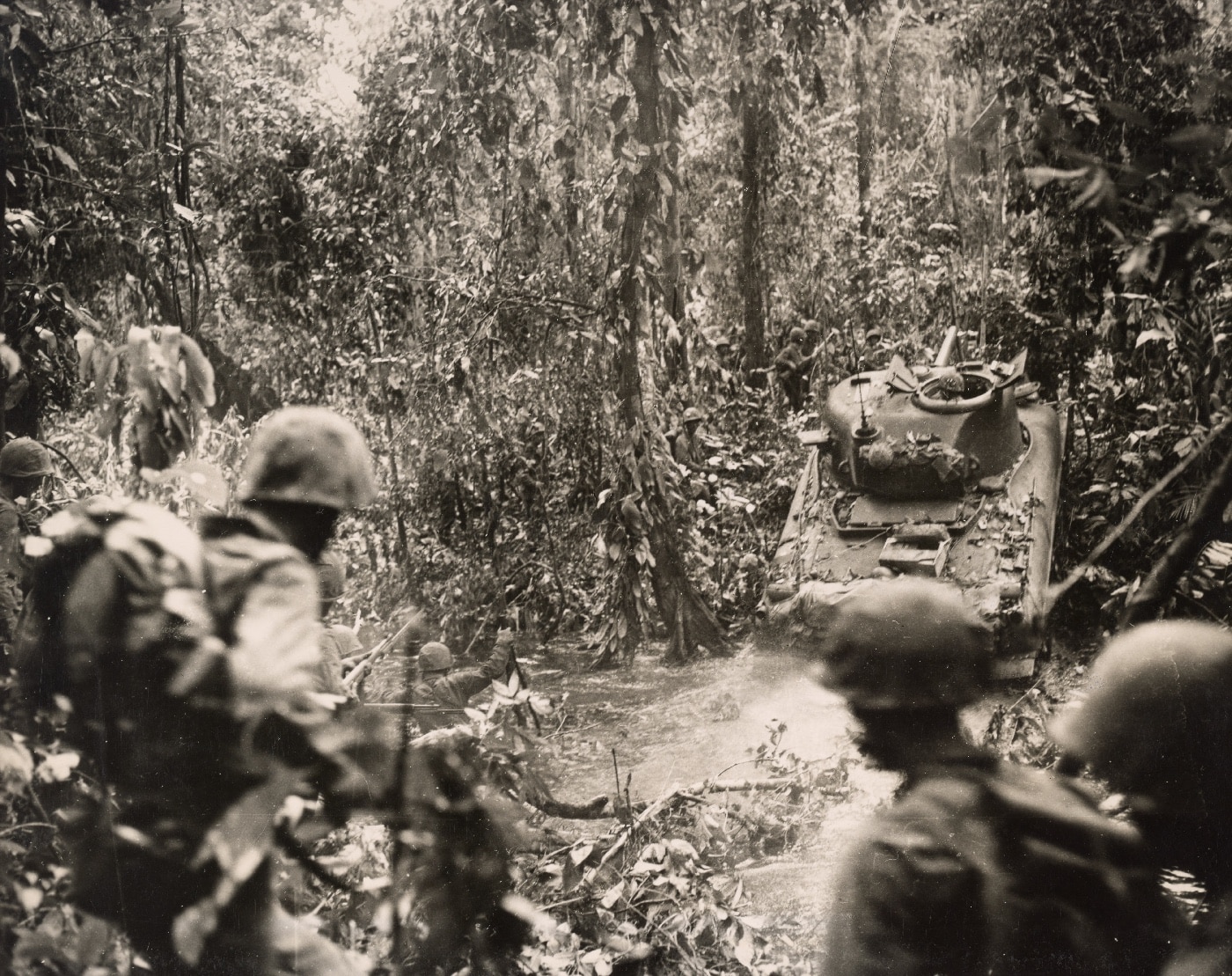
A Sherman tank climbs a Cape Gloucester bank after crossing a river. The Marine riflemen and tanks worked together to defeat the Japanese troops on the island. Image: NARA
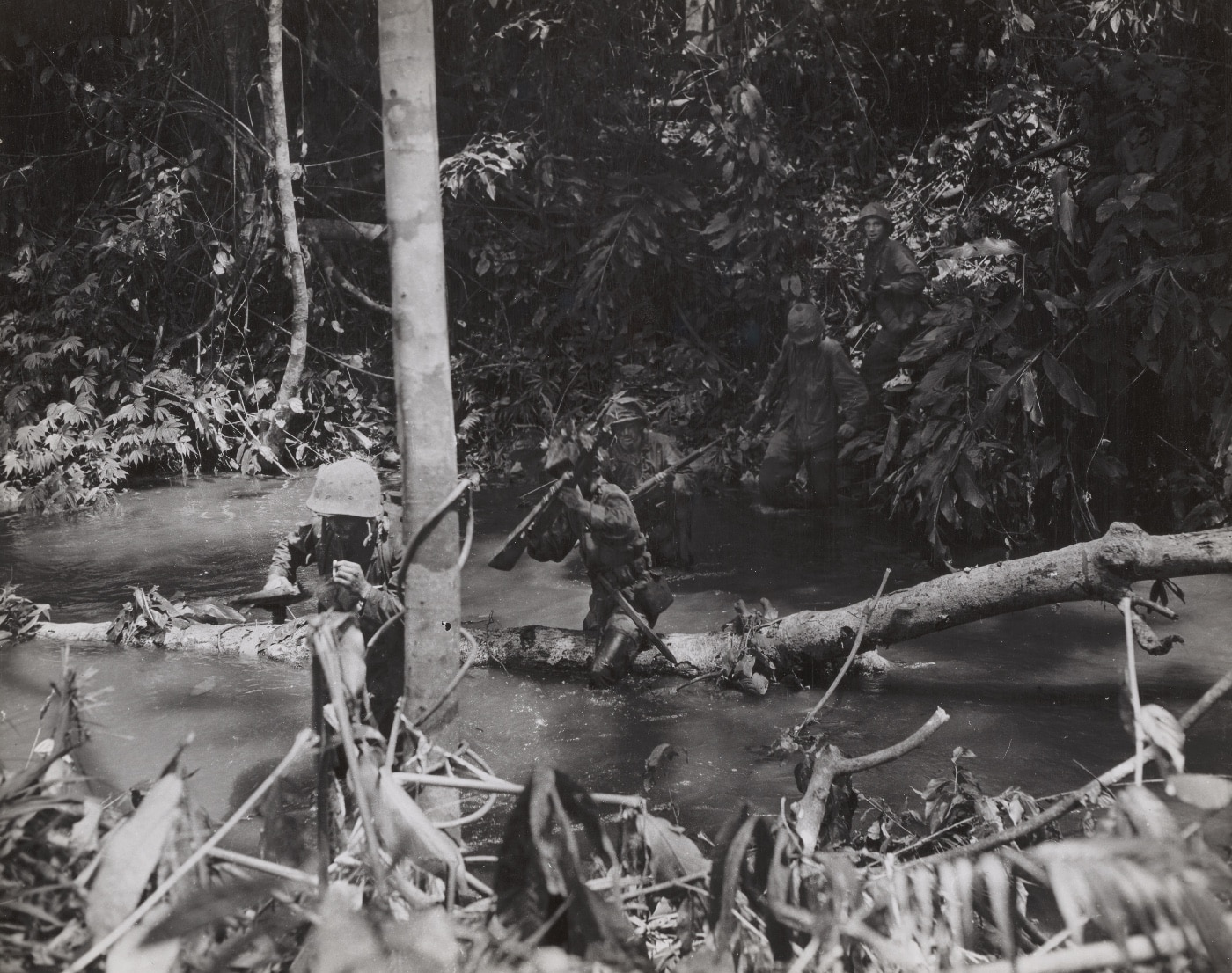
Marines cross a Cape Gloucester stream, constantly on the alert for Japanese snipers. Image: Tech. Sgt. R.R. Brenner/U.S.M.C.

Marine engineers work to build a river crossing on Cape Gloucester. Note also the chains used on the vehicle tires to try to deal with the island’s mud. Image: U.S.M.C.
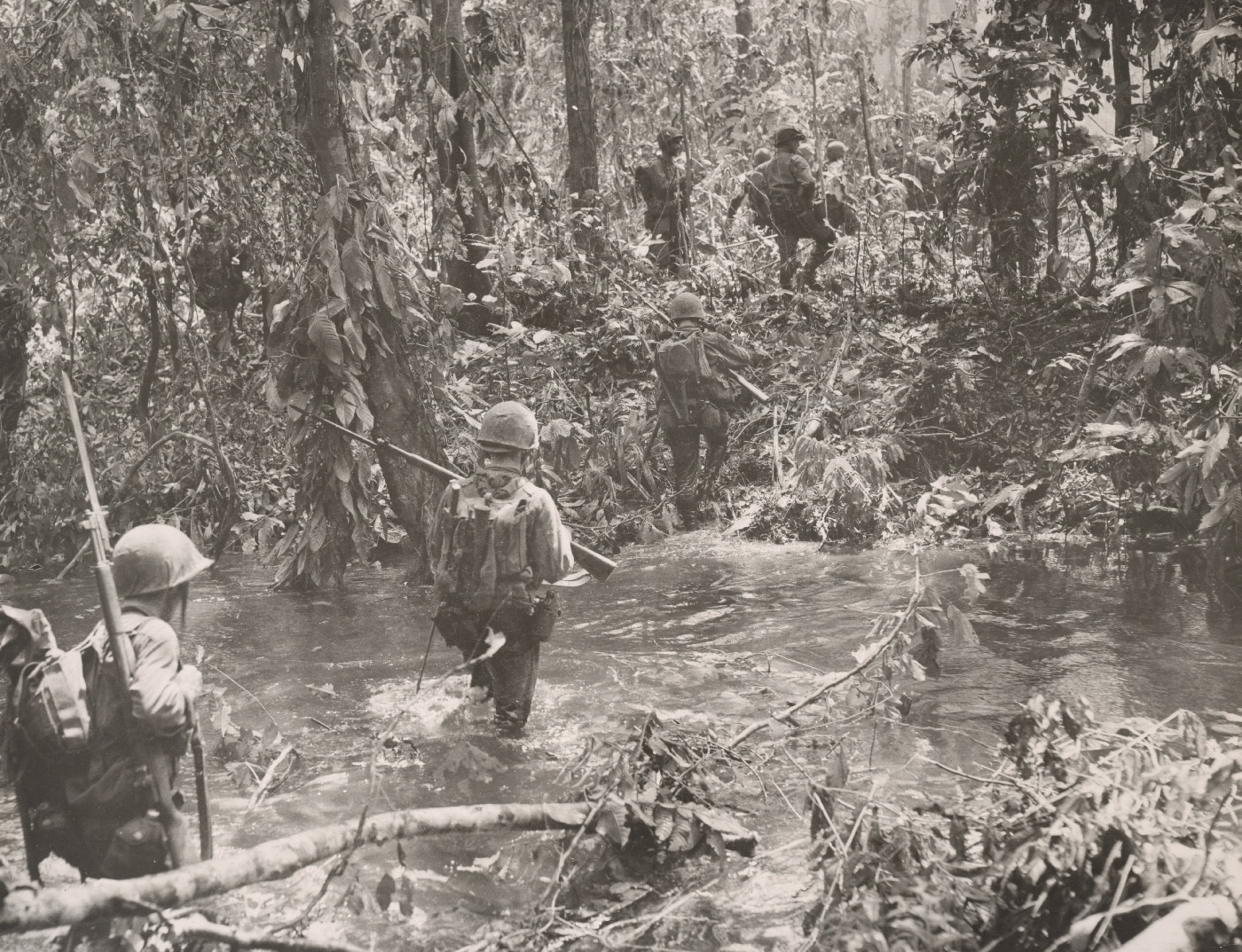
U.S. Marines cross a stream on Cape Gloucester while moving forward to assault a Japanese pillbox. Image: NARA
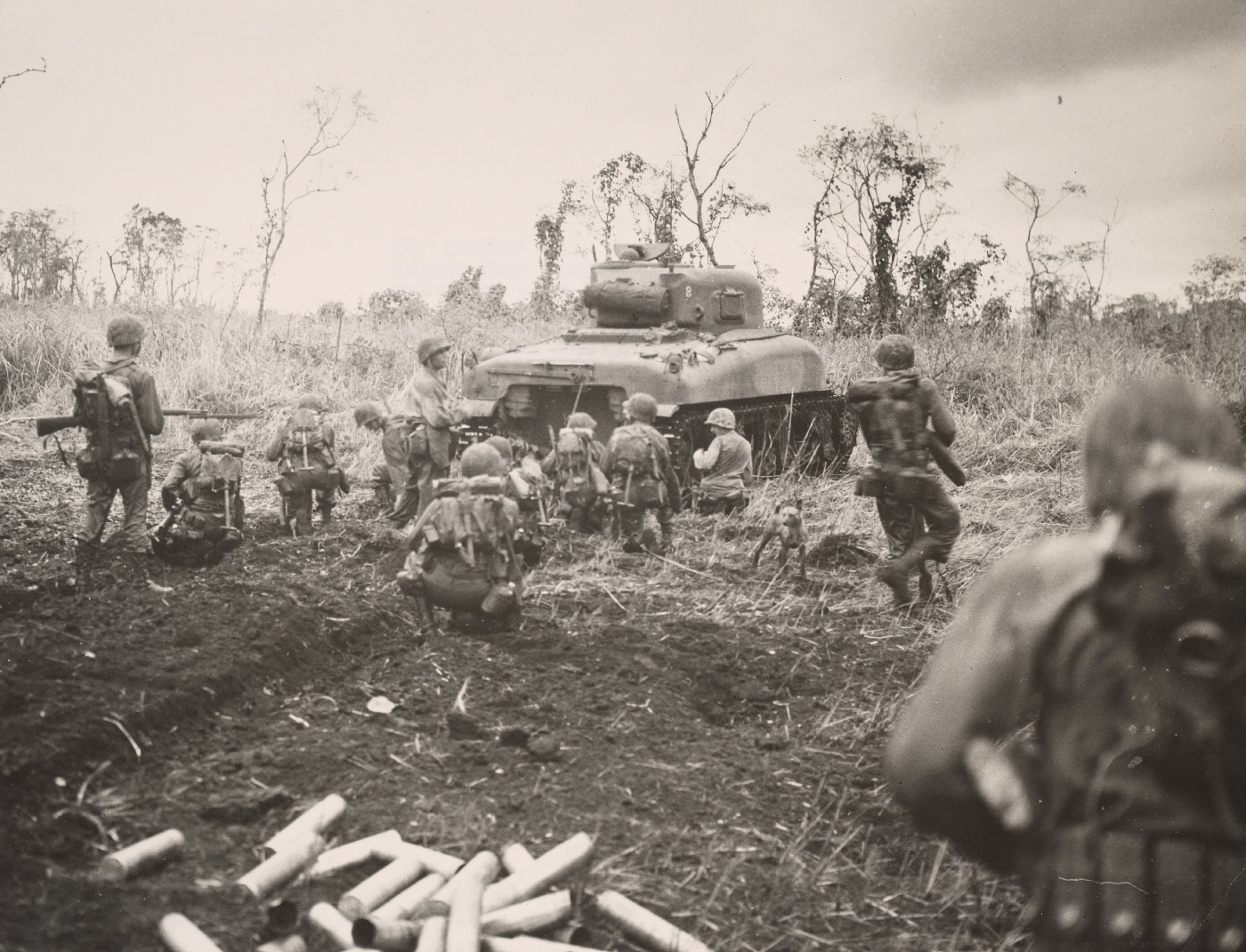
Close to Cape Gloucester’s airport, this M4 Sherman tank just fired into a Japanese pillbox and is ready to advance with the infantrymen. Image: NARA
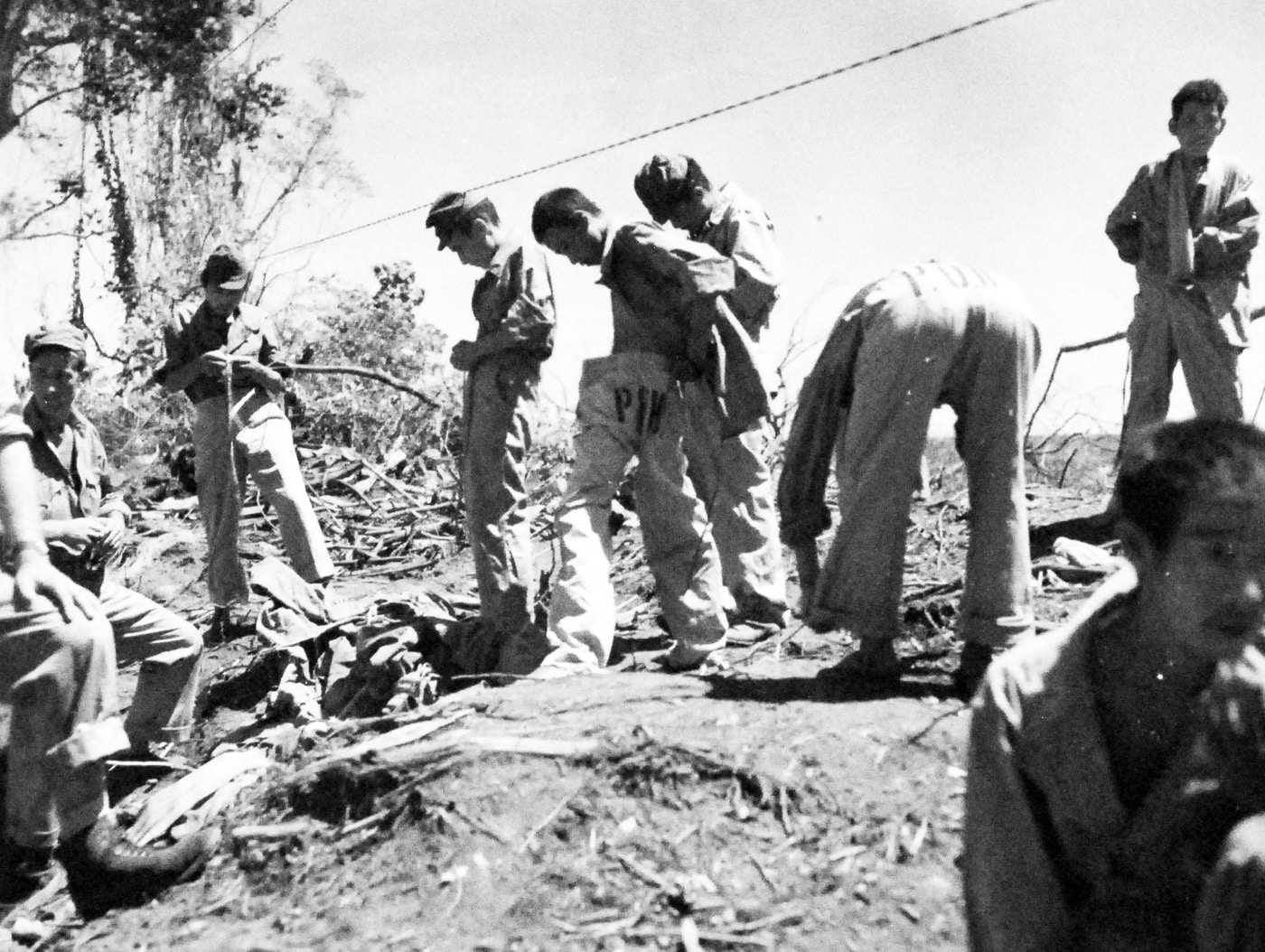
These Japanese soldiers surrendered to U.S. Marines at Cape Gloucester. After being taken as prisoner, they were fed and provided clean clothes. Image: Howard/U.S.M.C.
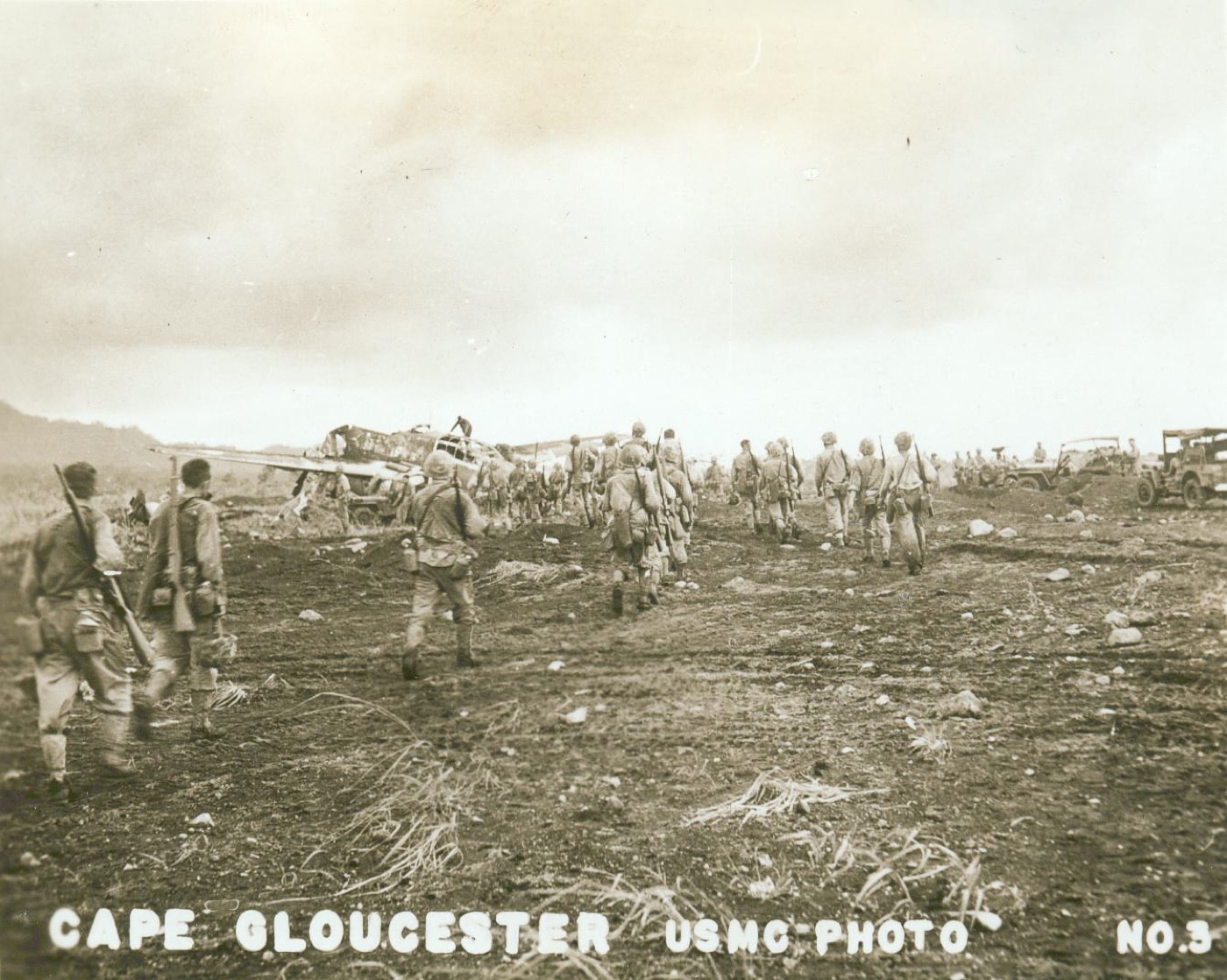
Securing this Japanese airbase was one of the main objectives of the Battle of Cape Gloucester. Image: U.S.M.C.




